Although most people know that London is littered with stunning iconic landmarks that are world-famous, there are a huge number of equally (if not more) impressive landmarks across the rest of England that may not get the same global recognition. So, to help us count them down, we asked some of the top travel writers and bloggers to share their favourite landmarks in England, in this ultimate guide.
There are so many amazing attractions in England that we’ve had to limit this to a top 30 landmarks list, but there are so many other landmarks that could have made the monumental grade. We’d love to hear from you if you think that there are any obvious ones that are missing – hit us up in the comments below if your favourite English landmark didn’t quite make the mark.

Skip ahead
Our top 10 landmarks in England
Although we’ve got a list of the top 30 famous landmarks in England, we’ve tried our darndest to whittle that down to what we’d consider our absolute favourite 10. This was no easy exercise and we had a lot of discussions over here at The Travel Scribes HQ to choose this list of ten epic landmarks in England:
- London Eye
- Stonehenge, Wiltshire
- Buckingham Palace, London
- Windsor Castle, Berkshire
- Tower Bridge, London
- Durdle Door, Dorset
- Lindisfarne Castle, Northumberland
- Big Ben and Houses of Parliament, London
- Hadrian’s Wall, Cumbria & Northumberland
- Westminster Abbey, London
London Eye
Explored by Chrysoula from Historic European Castles
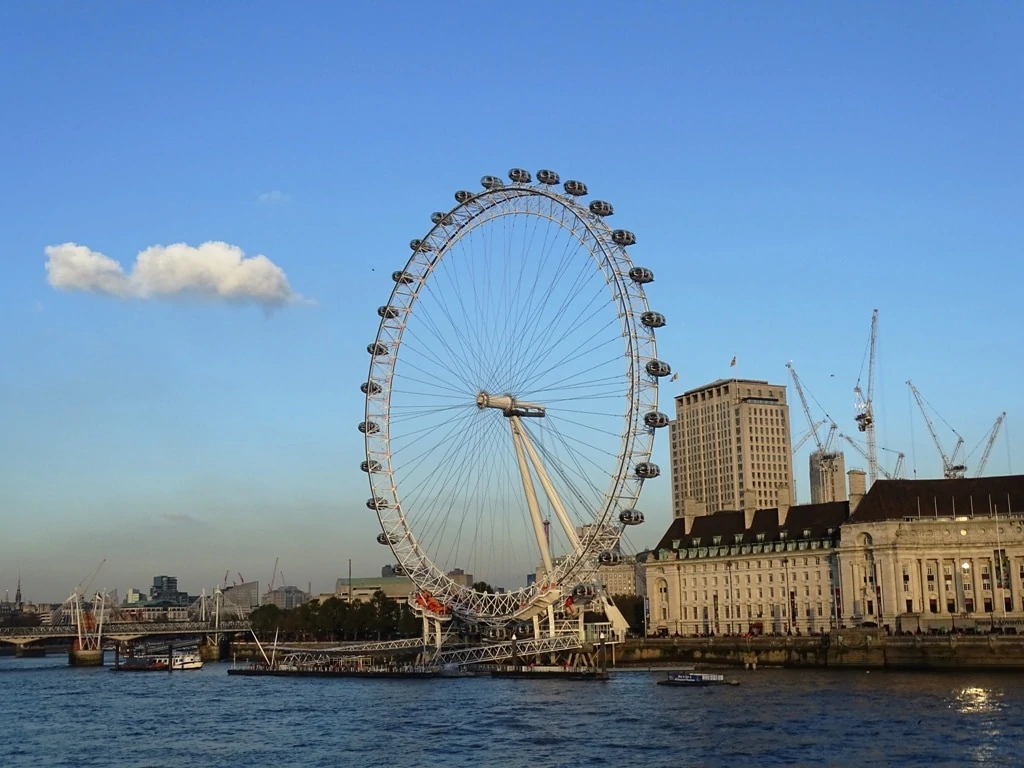
The London Eye is one of the capital’s many iconic structures with millions of visitors flocking to see the city from its pods every year. Standing at a height of 135m, the London Eye (or Millennium Wheel as it’s sometimes called) is Europe’s tallest cantilevered observation wheel and is one of the UK’s most popular attractions.
Being one of the highest public viewing points in the city, the London Eye offers guests outstanding views of the capital, with panoramic vistas looking out over the River Thames, the Palace of Westminster, Tower Bridge, the Gherkin, Big Ben and even Buckingham Palace. Try to pick a clear day (if you can!) to really make the most of the views!
If you want to make your trip up the London Eye even more special, you can book out an entire pod for yourselves, perhaps for a champagne engagement trip or wedding anniversary or a private dining experience.
One revolution in the London Eye takes around 30 minutes, with the pods moving at all times – travelling slowly enough for you to take in all the impressive views but not too slowly that you’d get bored.
Guests can reach the London Eye by walking along the South Bank (near the Jubilee Gardens, Southbank Centre and the Tate Modern), with Waterloo, Charing Cross, Embankment and Westminster stations all being within walking distance. Alternatively, you could hop on one of the Thames Clippers that stop at the London Eye Pier just a few steps away.
Read next: The top 20 must-see landmarks in Croatia.
Windsor Castle
Explored by Rachel from Earth’s Magical Places
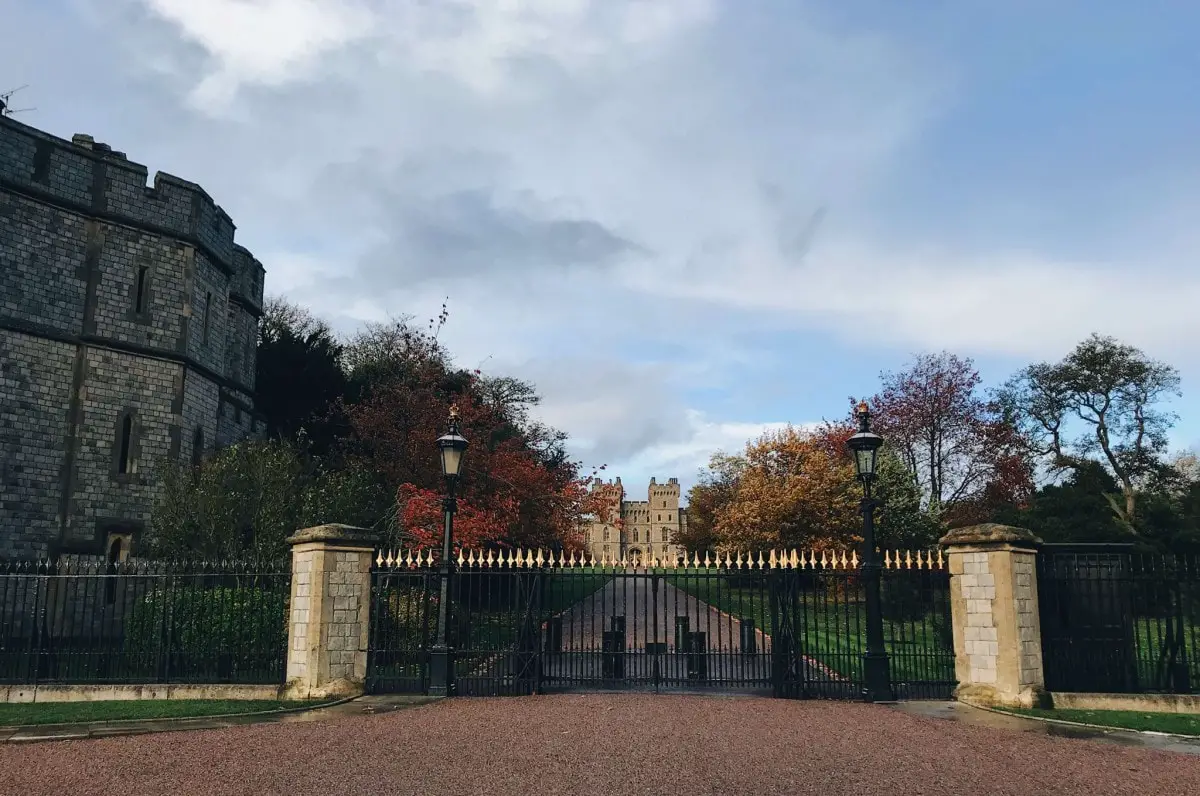
Windsor Castle is no doubt one of the most iconic buildings in the UK. Its origins can be traced all the way back to the year 1070 and William the Conqueror (the first Norman King of England). In this way, it’s unsurprisingly got a very rich history and one which continues to this day, as it’s known to be the Queen’s favourite home.
A top tip is to make sure you keep an eye out for the Royal Standard flying over the Round Tower when you visit, as this signals that the Queen is in residence!
However, what makes Windsor Castle so special is the fact that you get two iconic buildings in one. This is because the magnificent St George’s Chapel (which took centre stage for Harry and Meghan’s recent royal wedding) can also be found within the castle grounds.
On top of this, Windsor town is incredibly charming and well worth visiting all by itself! A walk around the historic Great Windsor Park, before traditional afternoon tea, and a pint at the ‘Queen Charlotte’ are just some examples of the quintessential British experiences that you can have.
Open to the public since 1993, it’s worth noting that you can buy tickets to tour both Windsor Castle and the Chapel, throughout the year. These can be bought on the day for around 23 GBP / 30 USD. However, it’s advisable to pre-book online in advance as the ticket queue can get rather long, especially in the popular summer months.
Related: The top 25 landmarks in Italy.
St Paul’s Cathedral, London
Explored by James from The Travel Scribes
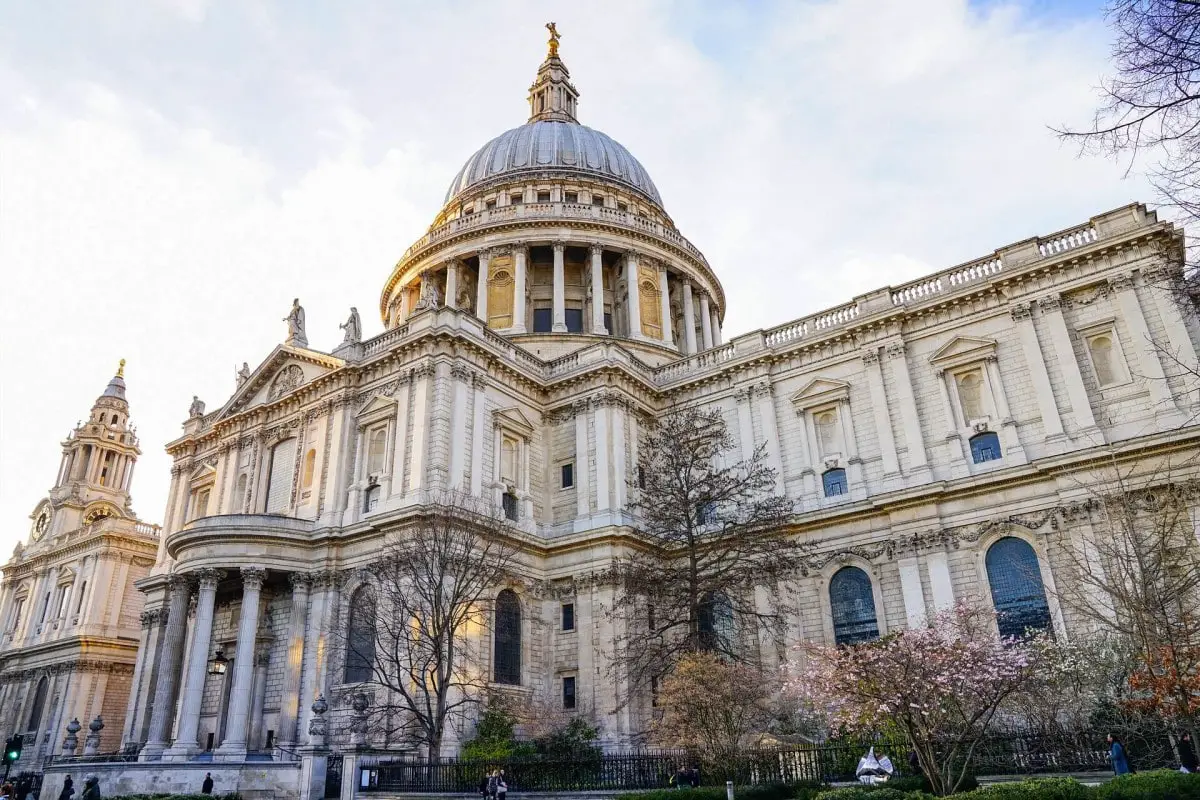
One of the most iconic London landmarks, St Paul’s Cathedral has been an ever present figure dominating the London skyline since it was constructed in the late 17th century by Sir Christopher Wren, as part of the rejuvenation project of London following the Great Fire.
With it’s famous dome rising to 111m, it held the title of London’s tallest building until 1963. Although is now eclipsed by the likes of The Shard, it is still a great sight and viewable from many parts of London.
Make sure you visit the Cathedral as part of any London itinerary, as you can still head up into the dome of the Cathedral, visit the Whispering Gallery, the Stone Gallery and the Golden Gallery – although the latter includes climbing 528 steps – it does offer amazing views.
Read next: Interested in checking out the best hidden gems in London?
Stonehenge
Explored by Jeff from Life of Y
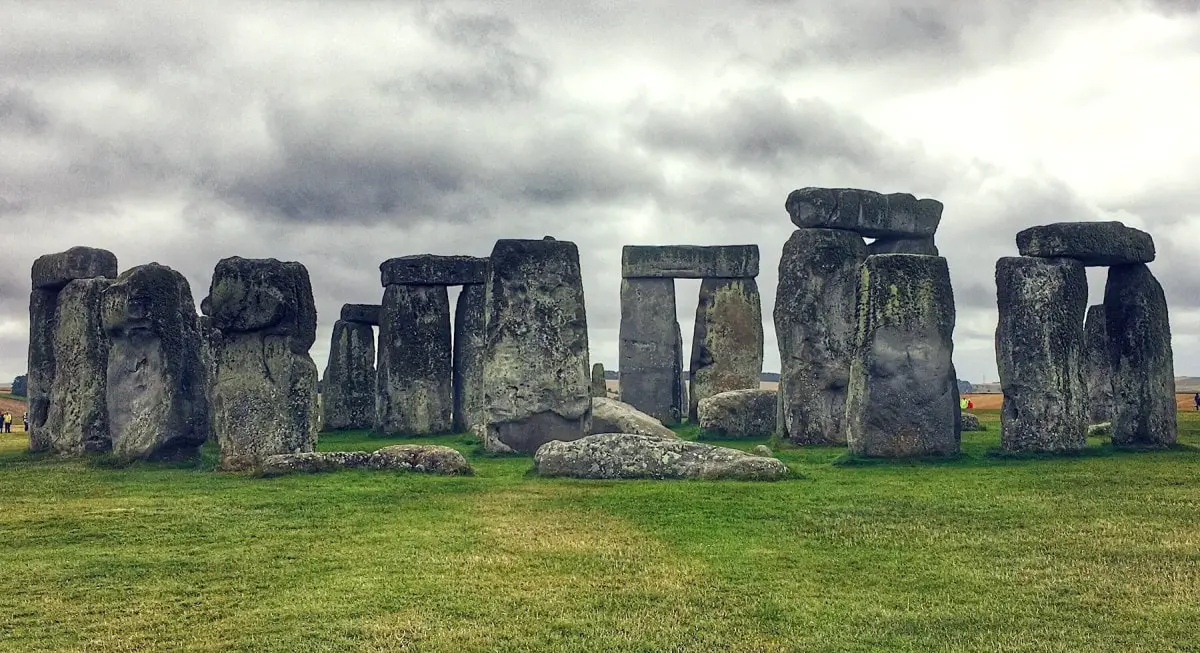
Stonehenge has got to be one of the most iconic landmarks, not just in England but, in the whole world!
It may just look like a load of large stone columns, but Stonehenge is shrouded in mystery and no one really knows who built them, what its purpose was or where the stones came from. In fact, one of the most searched queries on Google is what was Stonehenge used for?
Archaeologists believe that these giant stone columns are around 5,000 years old and took 1,000 years to build. There’s evidence to suggest that Stonehenge may have been used as a burial site at some point in its history. But it’s also believed that it was used for religious and ceremonial purposes.
The free audio guide will guide you through the site as you walk around the stone circle. Download it onto your smartphone and listen to the stories and theories as it takes you through the history of Stonehenge. After all, you wouldn’t want to visit a cultural icon without uncovering some of its mystery, would you?
Make sure you explore the visitor’s centre and exhibitions. Wander around the Neolithic Houses and learn more about what life was like from the volunteers. You can also try your hand at pulling a giant stone column to experience how heavy these things really are!
Top Tip: Stonehenge attracts nearly two million visitors every year so avoid the huge queues during peak times and book your time slot online to avoid disappointment.
Avebury Stone Circle
Explored by Larch from The Silver Nomad
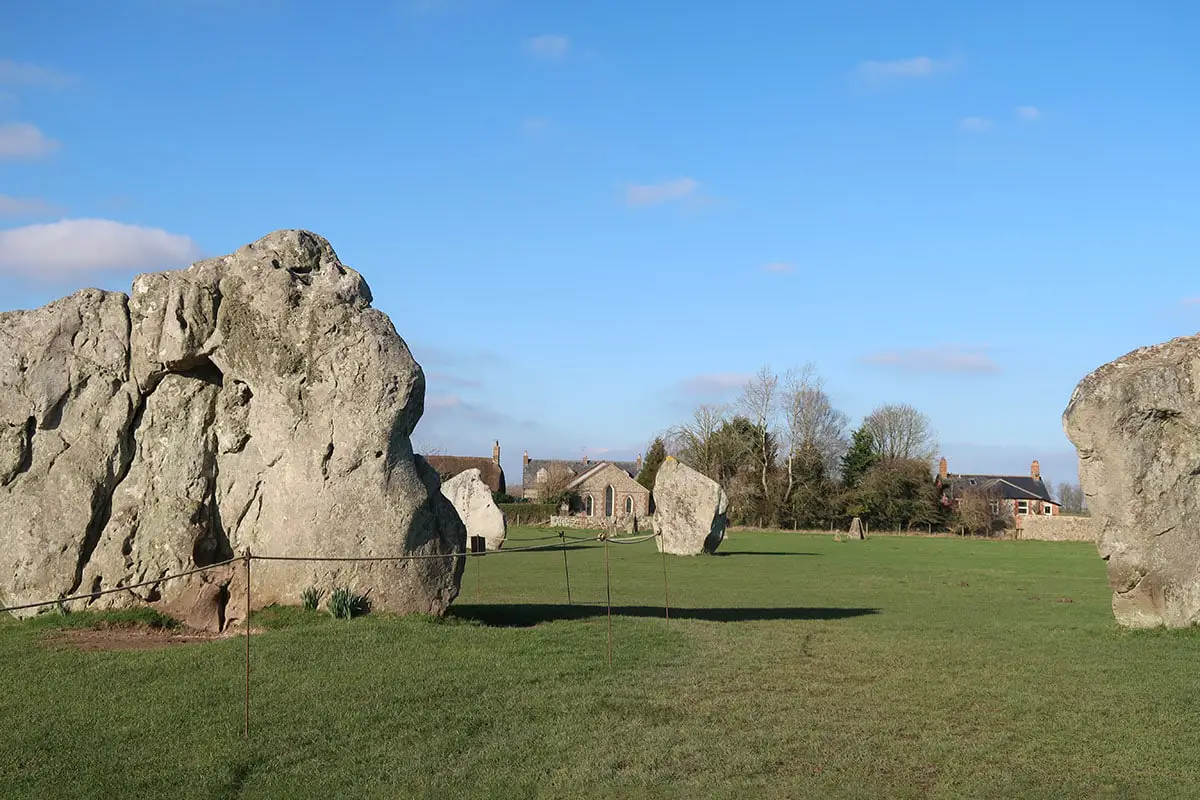
Smaller than its sister site Stonehenge, Avebury stone circle is no less impressive. With over 30 stones on the flat top of a henge with a deep ditch and banking surrounding it, it is much more accessible.
Dating back to 2850 BC and 2200 BC, Avebury is the largest stone circle in Britain with an outer diameter of 1088 feet. It is hard to imagine how 4000 to 5000 years ago they moved the stones, some of which are over 18 feet high and weigh up to 40 tons.
The best way to see the stones is to walk around the site which takes just over an hour. You can get up close and even touch most of the lichen-covered stones. Avebury village has grown up around the stones and is still used by farmers for grazing, so don’t be surprised to see a sheep pop out from behind one of the stones!
In the courtyard nearby, there is the Barn museum which follows the history of the site and many of the artefacts that have been dug up over the years are on show. You can also visit the Alexander Keiller Museum. Keiller who was an archaeologist was responsible for the maintenance and preservation of the Avebury site.
Avebury forms part of the UNESCO World Heritage site along with other Neolithic sites in the area: Silbury Hill, West Kennet Avenue, Windmill Hill, The Sanctuary, and West Kennet Long Barrow. Visiting all the historic sites makes for an interesting day out.
Radcliffe Camera, Oxford
Explored by Laura from What’s Hot?

The Radcliffe Camera is an iconic round library belonging to Oxford University and located in the very centre of Oxford. It was built in the 18th century in the neo-classical style and is a magnificent, rotund structure that you’ll see all around the city on postcards, sweaters and other souvenirs.
This library is part of the Bodleian Libraries, a network of Oxford University libraries in the city, but this is the most unique by far. A visit to Radcliffe Square, in between All Soul’s college and Brasenose college, is a must on any Oxford day trip and you’ll always find tourists taking pictures outside the Radcliffe Camera.
For a glimpse inside the library, you’ll have to book an organised 90-minute tour, which costs 18 GBP (24 USD) per person. This includes a visit to a number of important parts of the Bodleian Libraries including the Radcliffe Camera, Divinity School, Convocation House, Chancellors Court and Duke Humfrey’s Library. Some of these are Harry Potter filming locations so this tour is perfect for Potterheads in Oxford!
For the best views of the Radcliffe Camera, you’ll want to climb the tower of the Church of St Mary the Virgin, which sits on the High Street. From this high vantage point, you can experience incredible views of the entirety of Oxford, including the Radcliffe Camera, and see why Oxford is called the city of dreaming spires!
Hadrian’s Wall
Explored by Wendy from The Nomadic Vegan
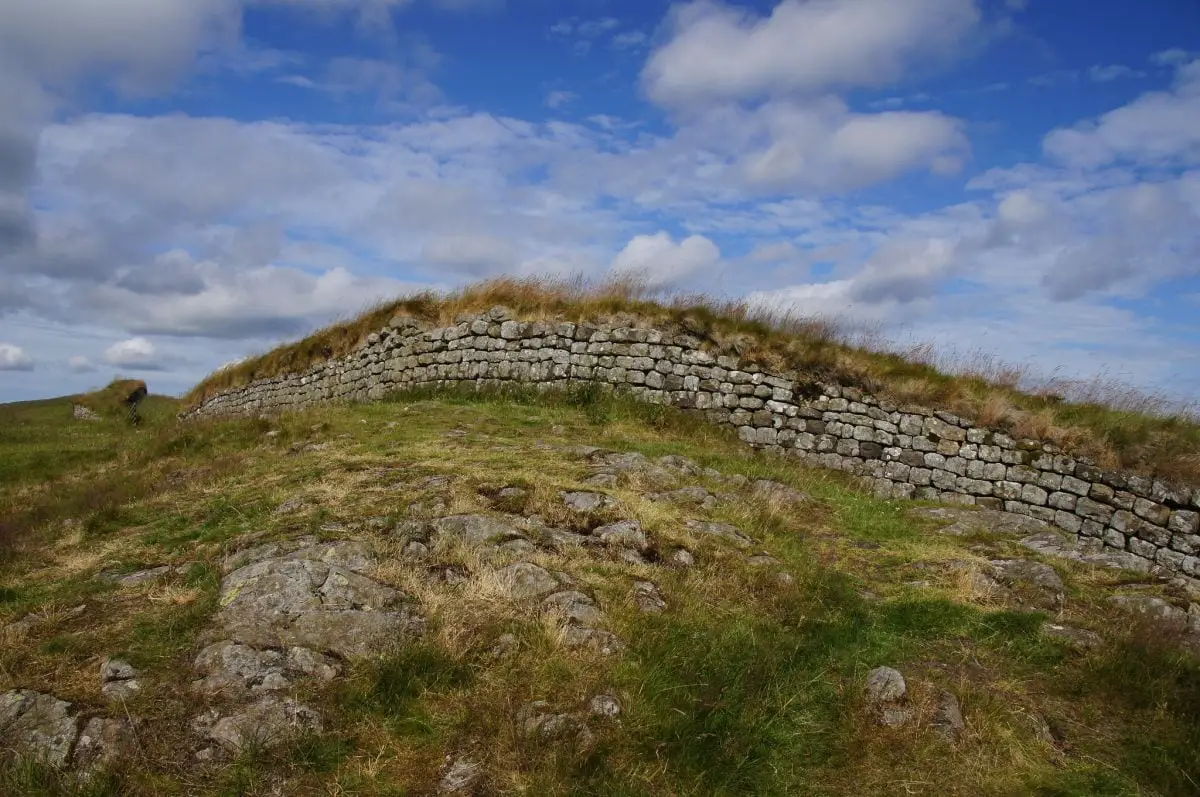
When it comes to landmarks in England, there are few that are more iconic or historically important than Hadrian’s Wall. Built in the year 122 AD on the orders of — you guessed it — the Roman Emperor Hadrian, this stone wall is hard to miss if you’re heading up to the northern border. That’s because it runs almost the entire breadth of the country, for a total of 84 miles.
The wall starts on the western coast at Bowness-on-Solway and stops just a few miles shy of the eastern shore, at a place that’s aptly named “Wallsend”. If you just want a quick jaunt alongside the wall, you could head to Newcastle and walk east, effectively hiking the initial five miles of the Hadrian’s Wall National Trail in reverse.
With a bit more time on your hands, you’re better off basing yourself in Hexham, which is near several of the most important attractions and heritage sights connected with the wall. These include Housesteads Fort, Chester’s Fort and Milecastle 42. The latter is one of the best-preserved of the many milecastles that punctuated the wall, separated from each other by a distance of one Roman mile.
And if you have a week to spare, why not cycle or hike along the entire length of Hadrian’s Wall? There’s no better way to experience the English countryside while also learning about the country’s long and illustrious history.
Buckingham Palace, London
Explored by Samantha from The Wandering Wanderluster
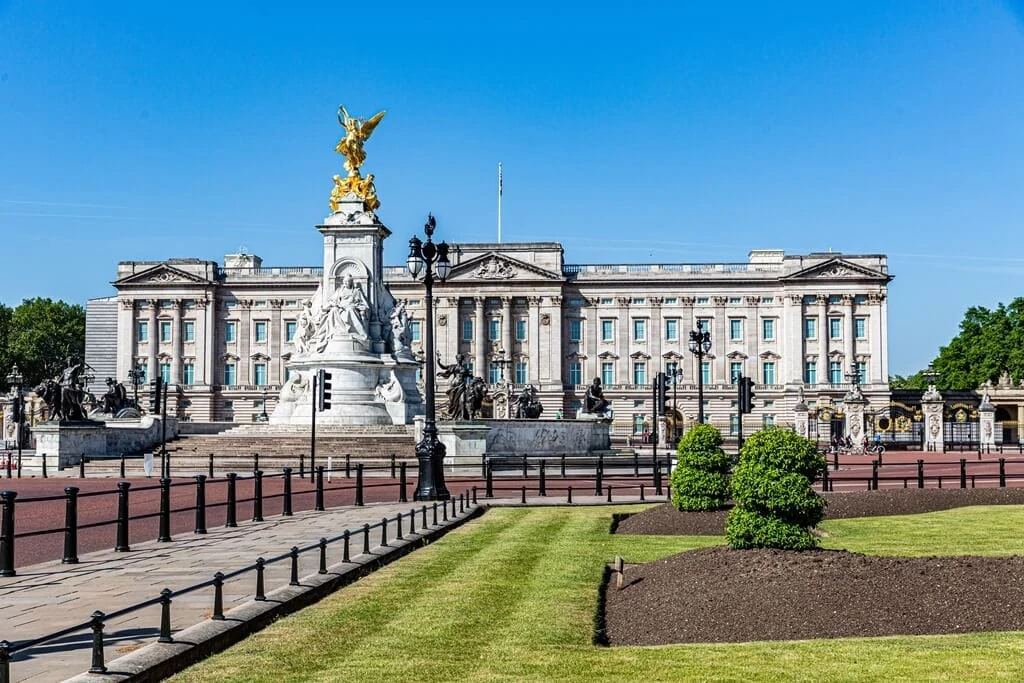
As England’s capital city, London is brimming with iconic landmarks and famous monuments. But no trip to London would be complete without visiting the “mother” of all British landmarks, Buckingham Palace. It is one of the few remaining working palaces in the world and the British Royal Family have been calling it home since 1837 when Queen Victoria ascended to the throne, making the palace the official London royal residence of the British Monarchy.
There are 775 rooms in Buckingham Palace including the 19 State Rooms and 78 bathrooms. Many of the State Rooms including the Throne Room and the Grand Staircase are open for public viewing during the summer months between July and September when the Queen typically leaves her London Residence for Windsor Castle or Balmoral in Scotland. Visitors can also visit the Royal Mews, home to the royal collection of historic coaches and carriages and The Queen’s Gallery featuring artworks from the Royal Collection.
The Royal Mews and The Queen’s Gallery can be visited anytime throughout the year and tickets can be purchased either separately or as a combined ticket. You can gain free entry to these two sites if you purchase a London Pass. State Room tickets must be purchased well in advance of the opening season, with tickets starting at around £25 per adult.
The Cotswolds
Explored by Lee from The Travel Scribes
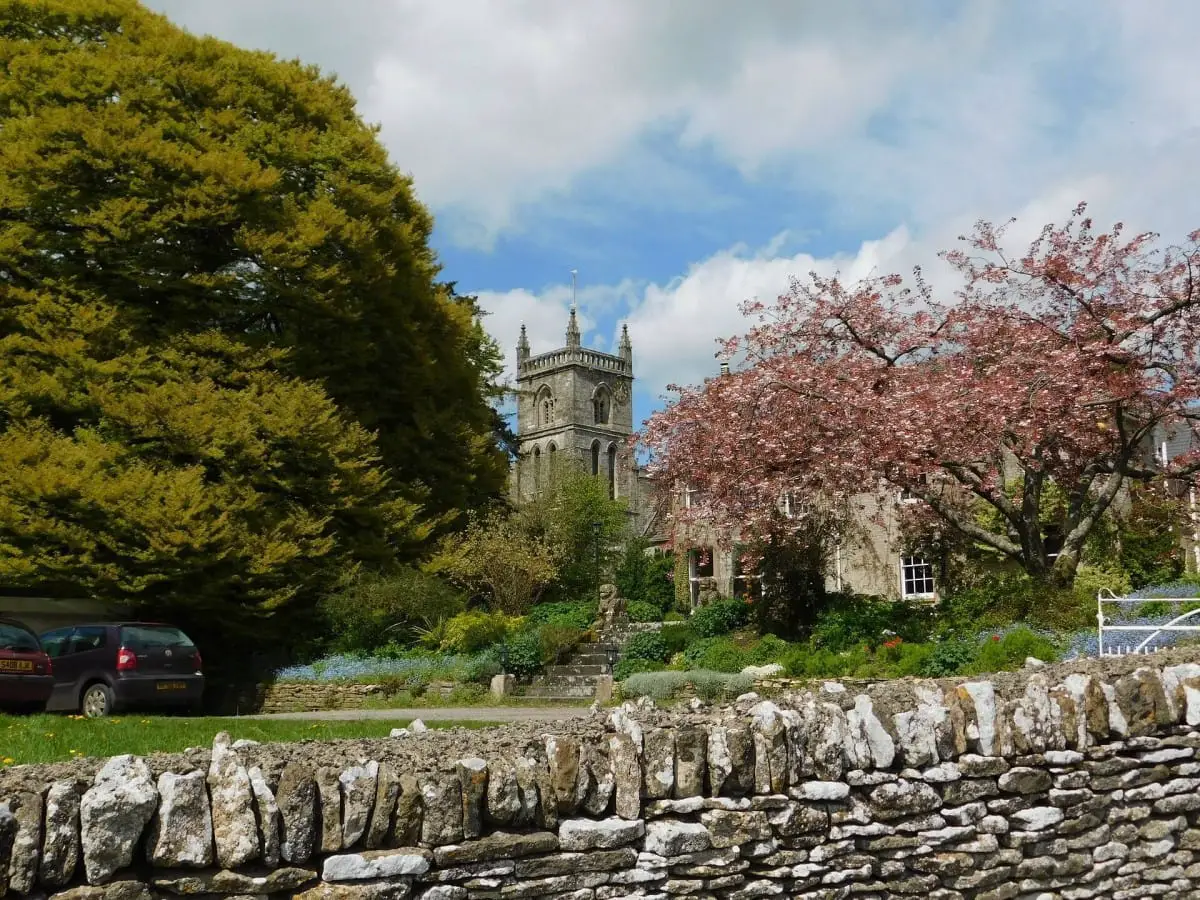
Nothing screams the English countryside better than the Cotswolds. Essentially just a region of England covering the south central and south west, the Cotswolds is known for it’s charming English market teams, including gorgeous cobbled streets and the honey-tinted stones that make up the cottages adorning the country lanes.
Punctuated by rolling hills, it was designated an Area of Outstanding Beauty back in 1996, showcasing the sheer magnificence of the area. Stretching from about Stratford-upon-Avon to just shy of Bath, the Cotswolds covers an area of about 2,000 kilometres (approximately 780 miles), making this definitely one of the largest landmarks in England!
Durdle Door, Dorset
Explored by Helen from Helen on her Holidays
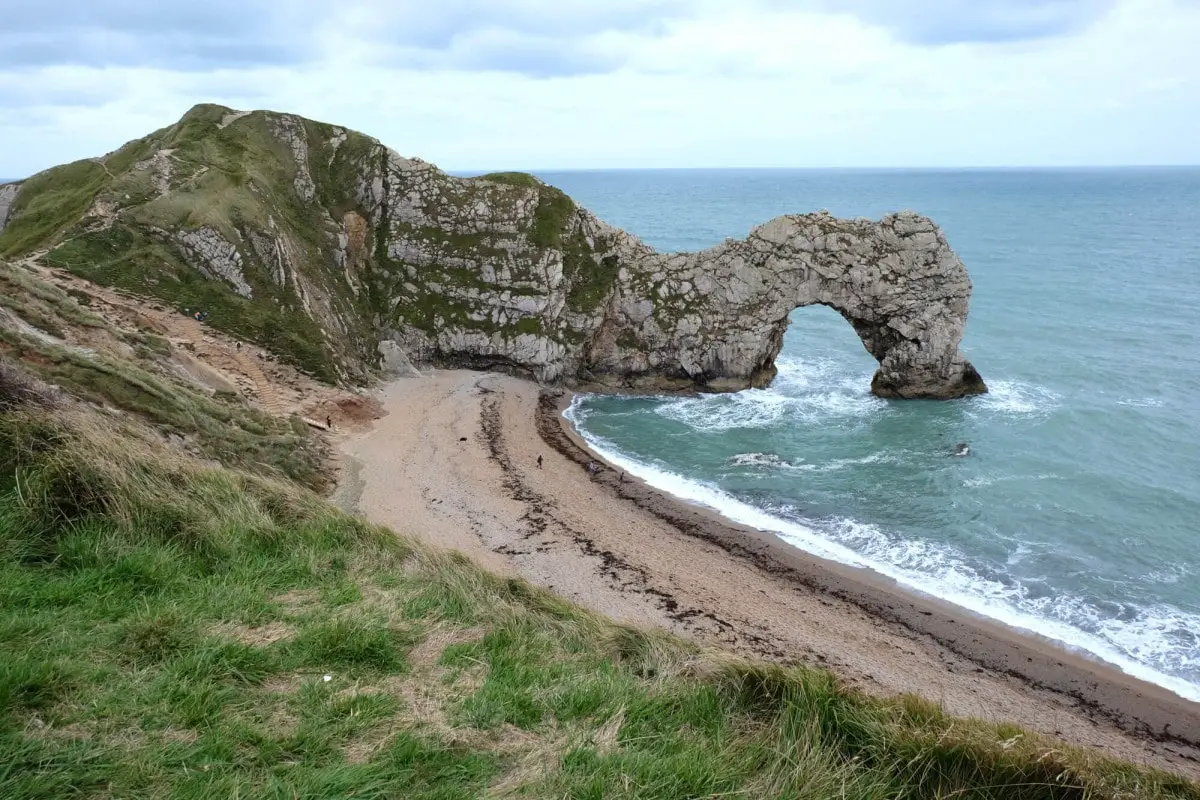
Durdle Door is on the Jurassic Coast in Dorset, one of the most beautiful parts of England’s south coast. It’s a natural limestone arch, set below a high cliff, with a sweeping sandy beach at its base.
The geology of the Jurassic Coast is particularly special. Millions of years of chalk, limestone and sandstone formation came together at this point on the coast near Swanage to create the optimum conditions for the lovely arch you see today to be formed. Elsewhere along the Dorset Coast you’ll find other quirks of geology like the almost-circular Lulworth Cove, the pillars at Old Harry Rocks, Chesil Beach, the giant sandstone cliffs at West Bay and the famous fossil beaches near Lyme Regis.
The nicest way to get to Durdle Door is by walking the South West Coastal Path. Lulworth Cove is only a short distance further along the coast, and the walk from the car park at Lulworth Cove is relatively short with spectacular sea views. From this direction, Durdle Door almost takes you by surprise, only revealing itself as you walk past the arch towards the beach beyond.
For a shorter walk, you can drive through the Durdle Door caravan park – there’s a car park on top of the cliff with a path leading straight to the arch.
Westminster Abbey, London
Explored by Anisa from the Two Traveling Texans
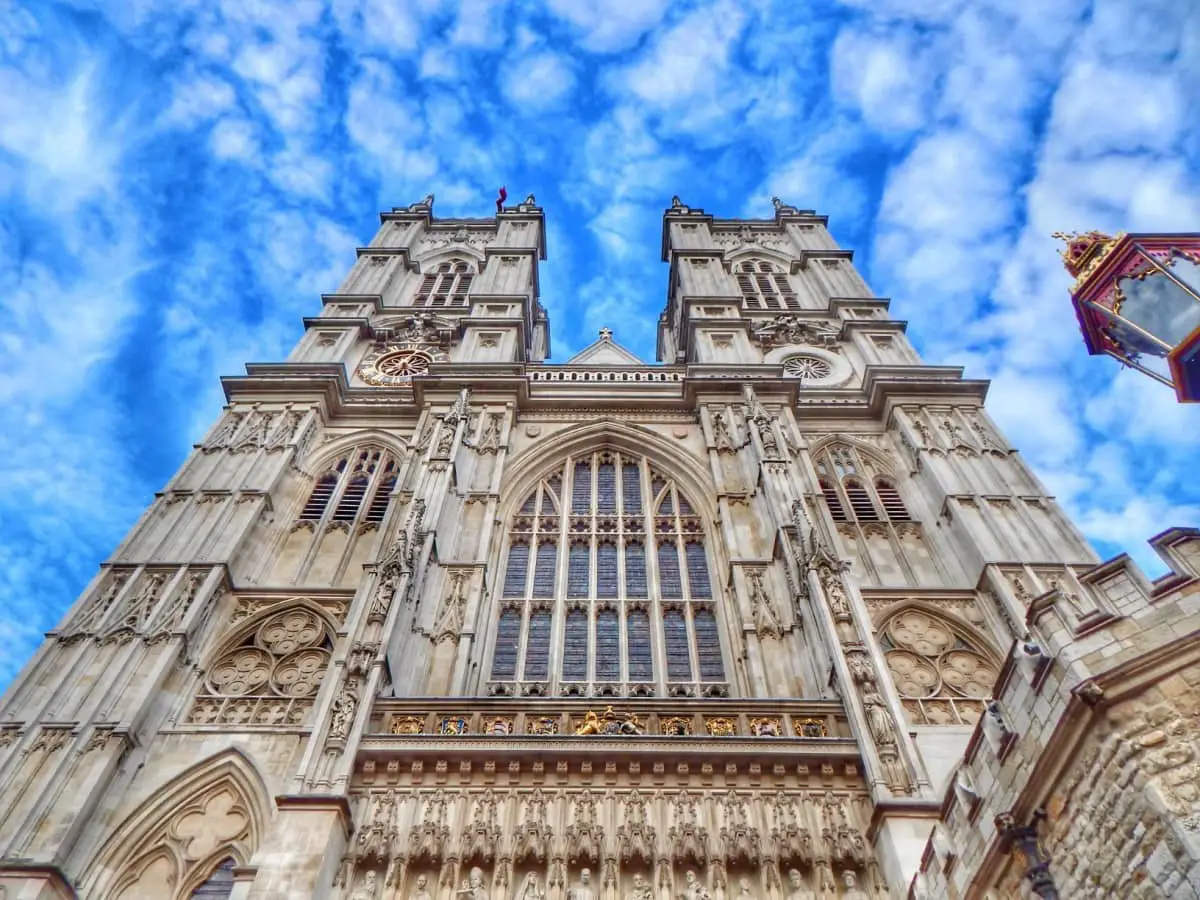
Westminster Abbey has been a place of worship for over 1,000 years. It has been the place for every English and then British coronation since 1066, 16 royal weddings and the burial of many monarchs, poets, musicians, scientists, and politicians. The Abbey is a UNESCO Heritage site and one of those places that you shouldn’t miss when visiting London.
The building is an excellent example of medieval perpendicular gothic architecture, but don’t just admire the Abbey from the street. There is a lot to see inside. Don’t miss the Tomb of the Unknown Soldier, Poet’s Corner, Quire, the Nave, Lady’s Chapel, the Chapter House, Cloisters, the Coronation Chair, and the Queen’s Galleries. The audio tour does a fantastic job of guiding you through the Abbey and teaching you about the history and the important people buried there.
We spent around three hours inside taking it all in. It is a bit pricey to visit Westminster Abbey, so if you plan on visiting other popular attractions in London, it might be worth it to get the London Pass. Also, be sure to dress appropriately as it is still a place of worship and note that they do not allow you to bring bags inside (other than purses) and there is no bag check.
White Cliffs of Dover, Kent
Explored by James from The Travel Scribes
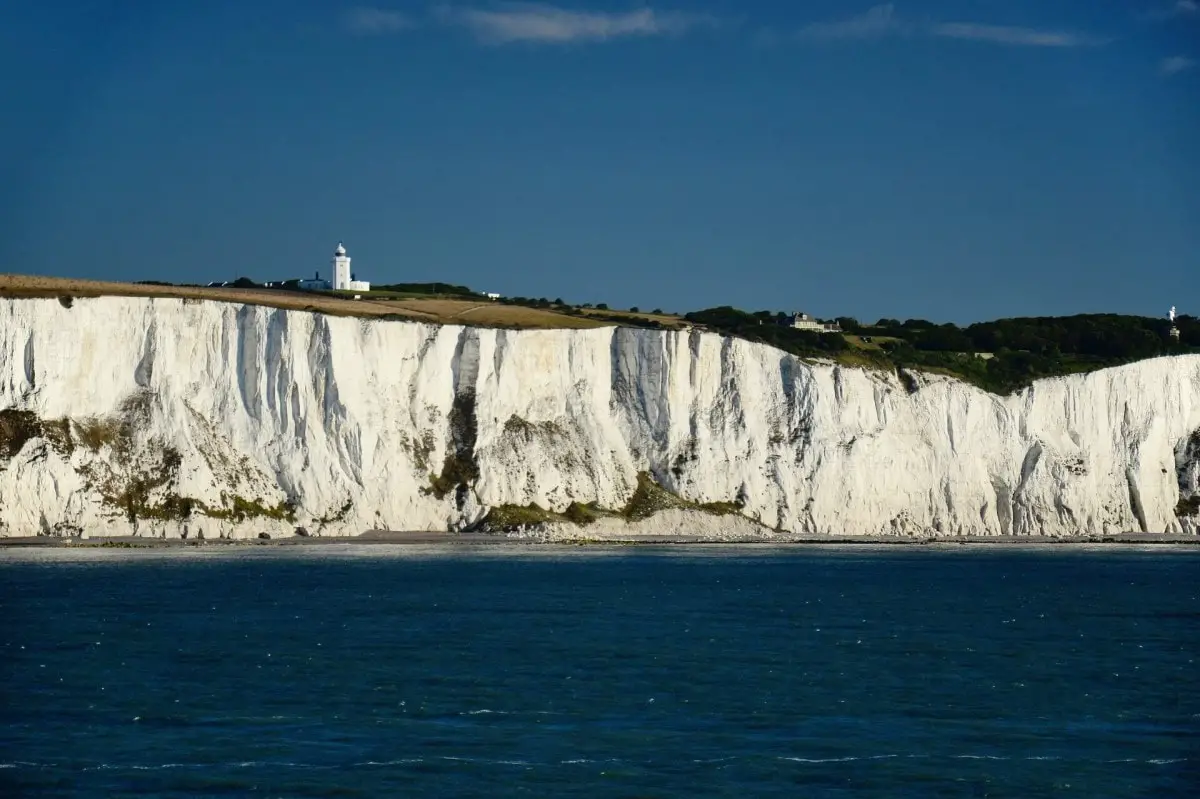
Part of the Kent coastline, the White Cliffs of Dover are a continuous cliff face that stretches for around 13 km (that’s around 8 miles) and raises out of the channel to over 100m tall.
Naturally formed from a soft white limestone – chalk – that built up over millions of years, these striking white cliffs (yup, hence the name!) can be seen from France on a clear day, and made up an important part of the UK’s World War II defences.
More than just military defence, this iconic natural landmark is a lovely place to explore, with wonderful walks up and down the hills. Wander along the coastal path towards the South Foreland lighthouse for epic views, and take in the lush plants and unusual animals, including the coveted chalkhill blue butterfly!
Glastonbury Tor, Somerset
Explored by Suzanne from Meandering Wild
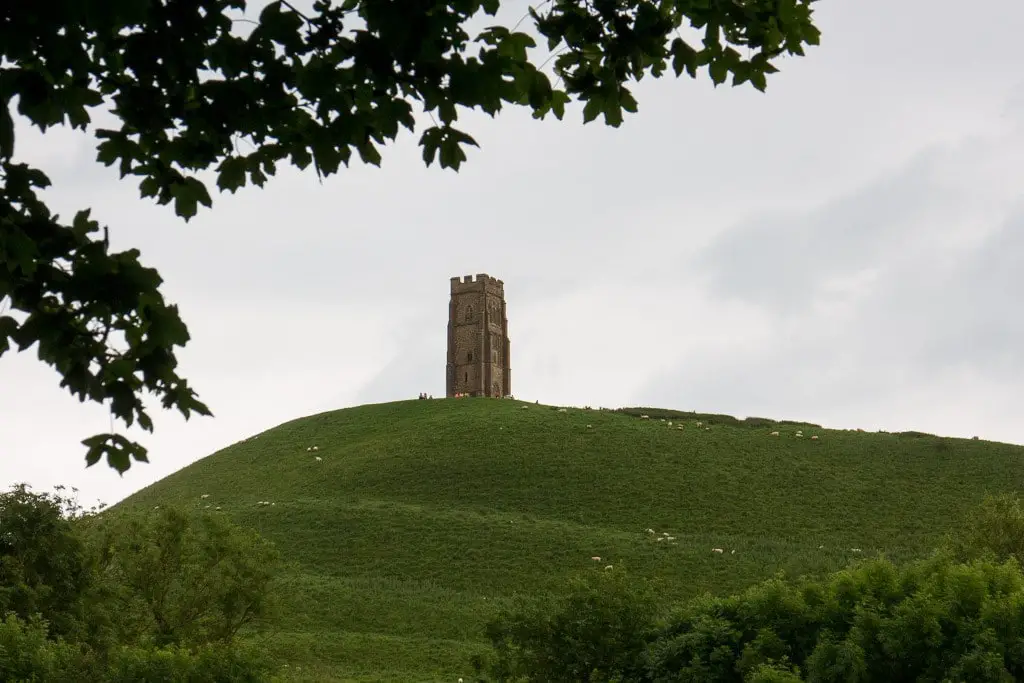
Glastonbury Tor is located above the small town of Glastonbury in the heart of the Somerset Levels approximately 30 miles south of Bristol and Bath and 140 miles south west of London. This hill rises out of the flat Levels to a height of 158 metres, a combination of natural rock and ancient terracing. From the summit there are far reaching views across Somerset, Wiltshire and Dorset as well as across the Bristol Channel to Wales.
On top of the Tor is the ancient 14th century church of St Michael. All that remains today is the iconic tower looking out over the landscape.
The Tor is steeped in ancient legends and it is believed that a hidden cave under the hill leads to the fairy cave of Annwn. It is a focus for many Pagans and Christians who gather on the Tor to watch the summer and winter solstice sunrises.
It is possible to walk from the town to the top of the Tor following a well-laid but steep path and is a perfect way to end a day in the area.
Glastonbury is probably best known for its annual music festival. This takes place a few miles from the Tor, but during festival week the summit can be busy although it is the perfect place to see the festival site laid out in the distance.
Clifton Suspension Bridge, Bristol
Explored by Susan from Thrifty After 50
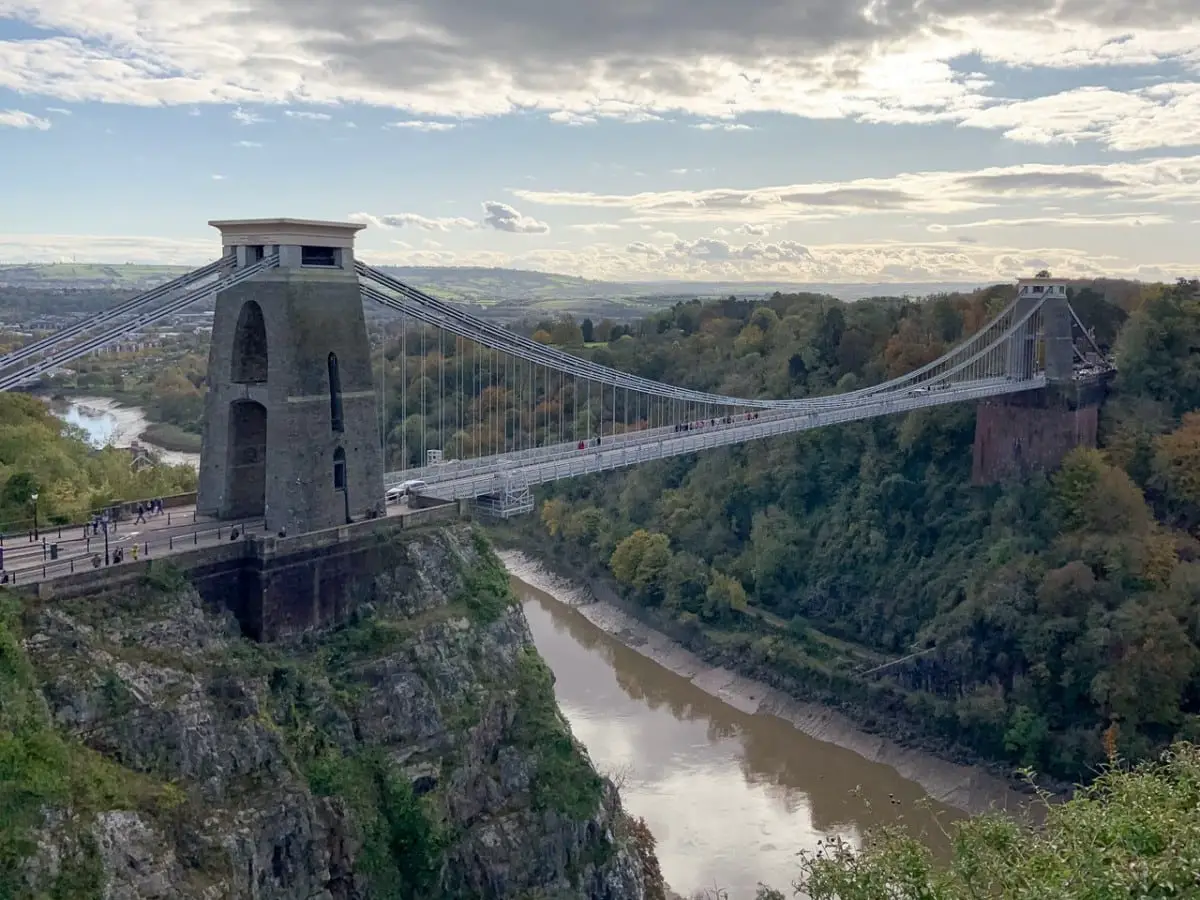
In the mid 1700’s, in the time of horse-drawn carriages, the only way to cross the Avon Gorge at Bristol was to use a ferry boat service or the heavily congested Bristol Bridge.
Bristol wine merchant, William Vick thought that the thriving port town of Bristol needed another bridge so when he died in 1753 he left a bequest of £1,000 in his will. He wanted a new stone bridge to be built across the Avon River that would be free for all to use.
By 1829 the money still wasn’t enough to pay for the construction of a stone bridge spanning the wide distance of the gorge. An Act of Parliament was required to change the conditions of the Will so that a wrought iron suspension bridge could be built along with the addition of a toll to recoup some of the costs.
Several competitions were held with the winning design going to Isambard Kingdom Brunel. The bridge is now considered one of his most recognisable structures.
The Clifton Suspension Bridge is a noteworthy landmark for several reasons:
- The bridge is the most iconic structure in Bristol
- The bridge spans 214m across the Avon Gorge
- For 97 years the Clifton Suspension Bridge had the longest span in Britain
- The bridge is referred to as the “turning point in the history of engineering”.
The bridge will cost you £1 (1.30 USD) to drive across but is free for pedestrians. There is a free Tourist Centre where you can learn about Isambard Kingdom Brunel’s first bridge.
Durham Cathedral
Explored by Sinead from Best in York Guide
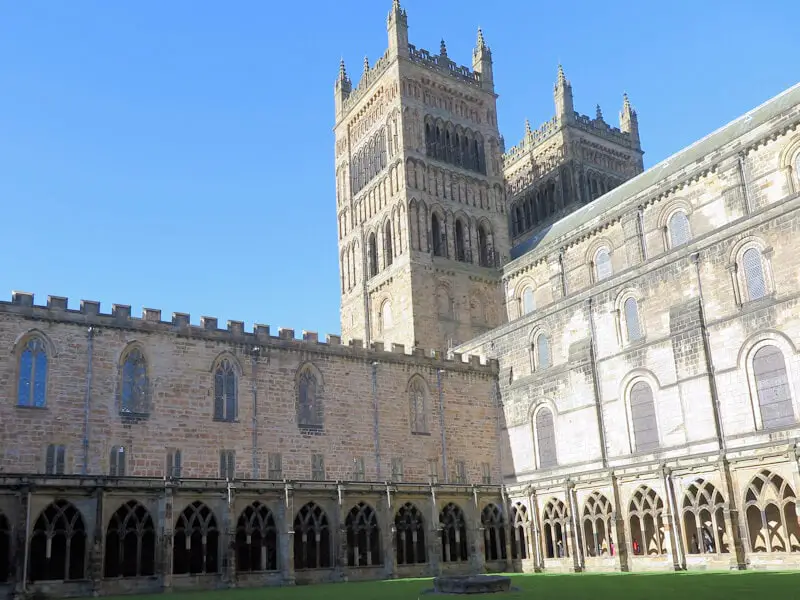
The UNESCO listed Durham Cathedral is an unmissable building in England. The imposing cathedral dominates the skyline of Durham – it was built on the highest point of the city – and has been a popular pilgrimage site for thousands of years. The current cathedral completed construction in the 12th century and is the seat of the Bishop of Durham.
It is famous for holding the relics of St Cuthbert and St Oswald but in recent years the cathedral cloisters have gained notoriety after doubling as the exterior of Hogwarts in the Harry Potter movies. The cathedral is stunning inside with a breath-taking mix of ornate architecture and rich toned colours. Intricate Romanesque arches sit atop thick, Norman era pillars leading to the High Altar and the 13th century Chapel of the Nine Altars. Diverse stained-glass windows from across the centuries throw a myriad of colours onto the stone flagged floor. Particularly striking is the 18th century Rose Window.
Other highlights include the beautiful Cathedral Clock and the Galilee Chapel. Energetic visitors can climb the 137 steps of the cathedral’s north west tower for an unforgettable view over the historic city of Durham. One hour guided tours to discover the history and stories of the iconic Cathedral are available daily.
Lake District, Cumbria
Explored by Lee from The Travel Scribes
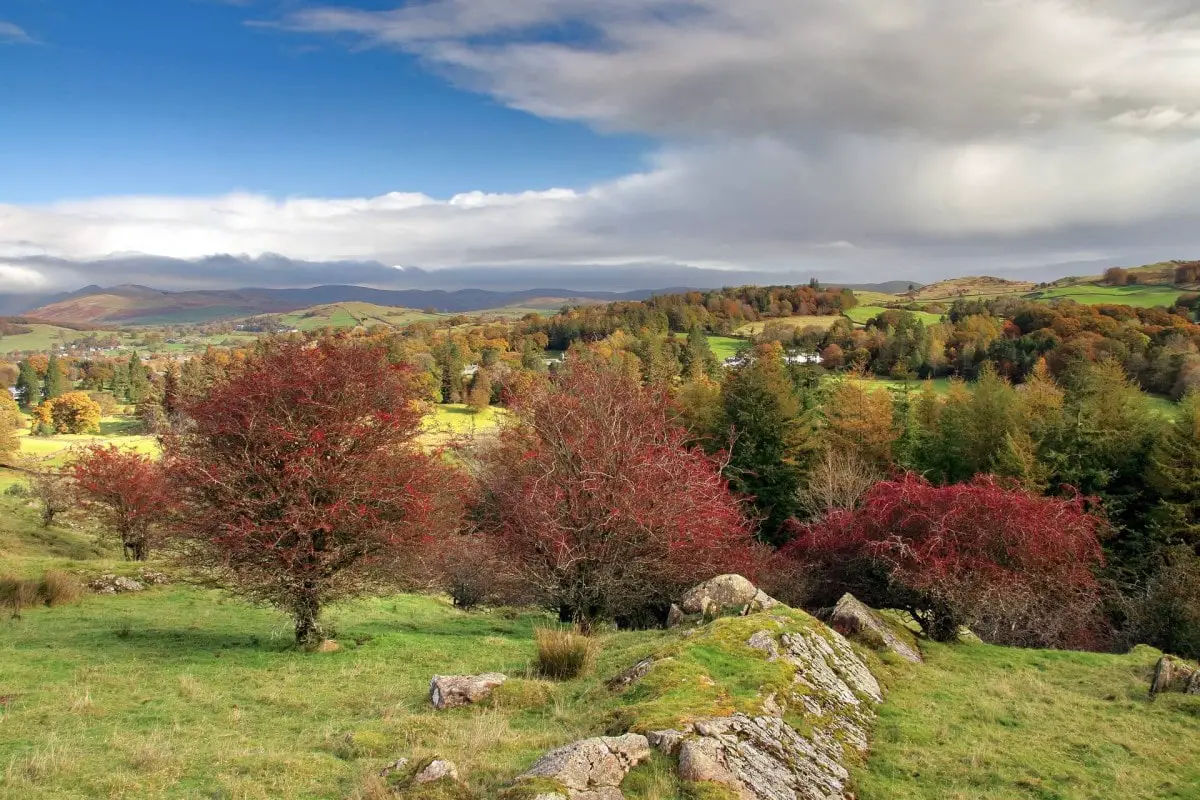
Located in the charming area of Cumbria, the Lake District (also known as ‘The Lakes’ or ‘Lakeland’) is an absolutely spectacular area punctuated by stunning forests (and lakes, of course), abundant wildlife and a bevy of brilliant things to do.
An iconic landmark, the district is crowned by the Lake District National Park, a UNESCO World Heritage site spanning over 2,000 square kilometres. Hike up Scafell Pike, the tallest mountain in England, or explore the country’s largest natural lakes, Wast Water and Windermere.
Or, if you’re not a nature enthusiast, indulge in some of the great cultural pastimes of this area – a ride on a historic steam train, many a museum to wander, art galleries, expansive landscaped gardens and attractions dedicated to poet William Wordsworth or the rousing line-up of characters featured in the books of famous author, Beatrix Potter.
Kings College, Cambridge
Explored by Sarah from Live Dream Discover
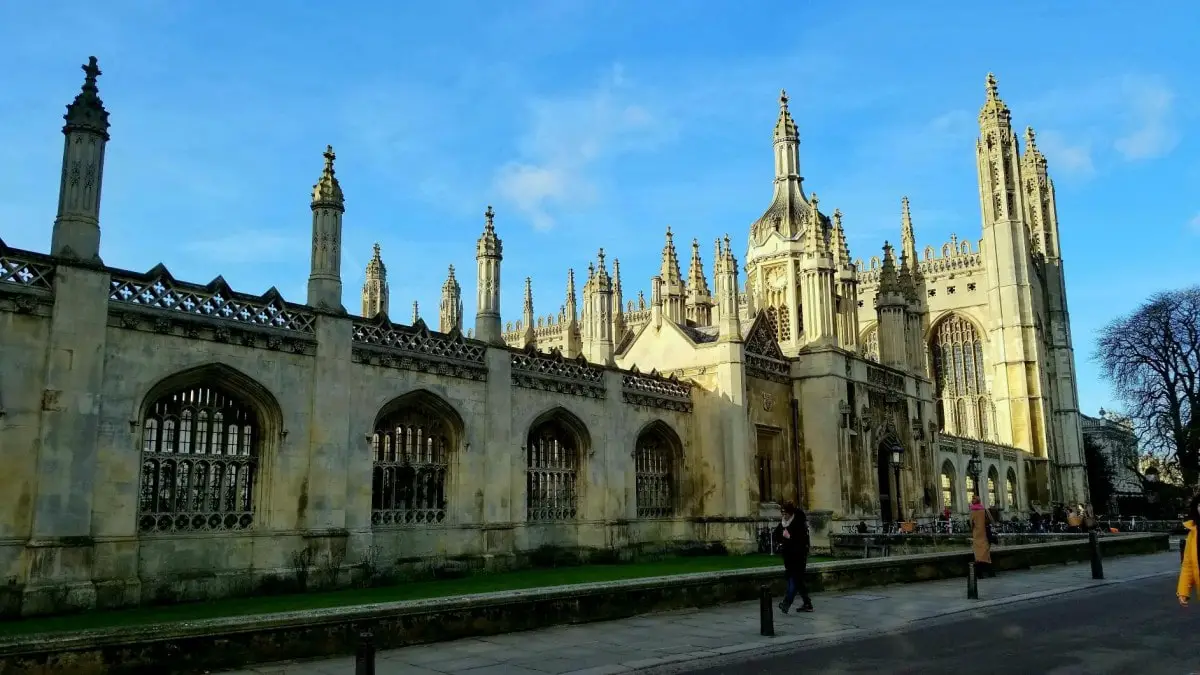
The beautiful and iconic Kings College was founded in 1441 by King Henry VI, who was known for his love of education. Today, it’s one of 31 colleges that make up the famous University of Cambridge. The city of Cambridge is lovely and makes a perfect day trip from London by train in just one hour.
Kings College is a stunning piece of architecture and is probably the most displayed image representing the city of Cambridge. Although it’s very much a working college, there are areas open to public viewing, and it’s a must-see when visiting this photogenic city.
The college is situated right in the middle of Cambridge on the banks of the River Cam and faces onto the King’s Parade creating a striking scene in the historic centre. Kings College Chapel is said to be one of the greatest examples of English late Gothic architecture and is home to the famous Chapel choir made up of male students from Cambridge University.
An admission fee of 10 GBP (13 USD) includes a visit to the chapel and some of the impressive college grounds, although the grounds are closed during exam times, usually between April and June. If you are interested in attending a service, the Evensong and Choral services are open to the public and allow you to see the chapel for free. However, this is a religious service, so photography is not permitted as it is during a paid visit.
Whitby Abbey, Yorkshire
Explored by Nat from Natpacker
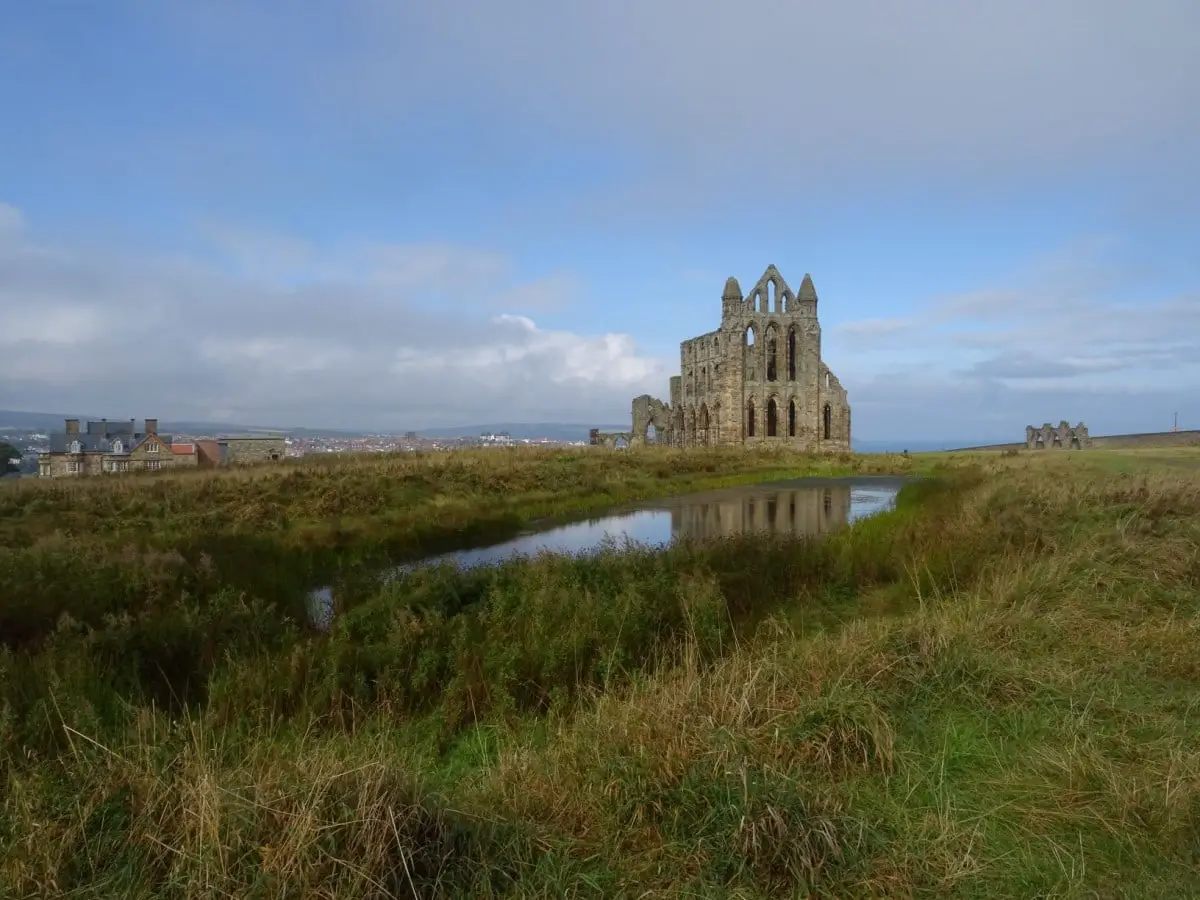
Located dramatically on the top of a cliff overlooking the coastal town of Whitby, Whitby Abbey is a recognisable landmark in England. The ruins have been an inspiration for many an artist over the years.
The Abbey has a lot of history, as it was founded in 657 by St Hilda of Hartlepool. It was during Henry VIII’s reign that the monastery fell into ruin, due to his Dissolution of the Monasteries. It is these ruins that are still on the site today.
Whitby Abbey ruins have inspired many artists over the year, but the most famous link is with Bram Stoker’s Dracula. The ruins feature prominently in the story, as Stoker stayed in Whitby for some time it’s no wonder the dramatic ruins inspired him.
The ruins are run by English Heritage, so if you are a member you can enter for free, otherwise there is a small charge. You can explore the ruins themselves, look out over the North Sea and the Town of Whitby, and learn the history of the ruins in the museum. Your ticket allows you unlimited entry all day, which is great if you park up here and want to explore Whitby too (make sure you go down into town via the 99 steps).
If you are visiting and driving yourself, you can park for free nearby. There are a few streets with no parking restrictions just a short walk from the Abbey. Alternatively, you can park on the official car park, but there is a charge.
Whitby Abbey is one of my favourite iconic attractions in England. The is so much history and the dramatic location of the ruins are spectacular.
St Michael’s Mount
Explored by James from The Travel Scribes

This stunning tidal island could easily be mistaken for Mont Saint Michel, the famous French landmark, but it is actually the Cornish counterpart of its namesake, and at low tide is linked to the town of Marazion, Cornwall’s oldest town.
It has a rich history, spanning back over 1,000 years and was given to the Benedictine order by Edward the Confessor back in the 11th century.
Crowned by an almost mythical castle and an old medieval church, this rocky jewel of a landmark also has many a tale to tell. Legend has it King Arthur battled a giant here, and there is a famous story of ‘Jack the Giant Killer’, a farmer’s son who felled a wild giant called Cormoran, to save the town.
Walk to St Michael’s Mount at low tide (find the tide times here) or, if impassable, catch a short boat trip out to this legendary landmark.
Read next: What made it on the list of most iconic landmarks in Germany?
The Tower of London
Explored by Claire from Tales of a Backpacker
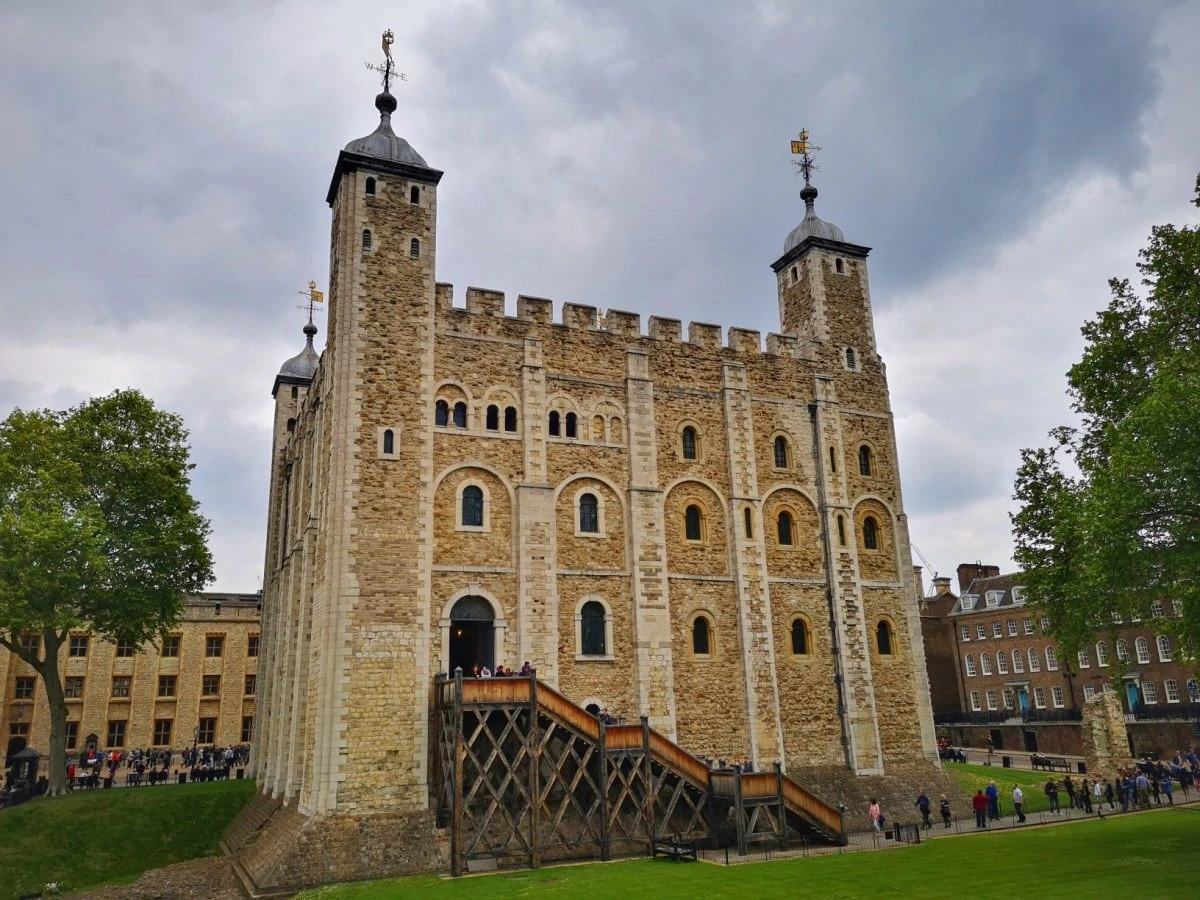
The Tower of London has been an iconic landmark in London for nearly 1000 years. It was built by William the Conqueror after his conquest of England and was a symbol of power and oppression over the people.
Throughout the years, the Tower of London has been used as a royal residence, a prison (with infamous prisoners including Elizabeth I before she became Queen, Ann Boleyn, Sir Walter Raleigh and Guy Fawkes), an armoury, the home of the Royal Mint and the Crown Jewels of England.
These days it is the most visited attraction in the UK, with visitors exploring the gruesome history of the Tower, taking a Tower of London Beefeater tour with the red-coated Yeoman Warders, and admiring the Crown Jewels.
The White Tower is now the Royal Armouries Museum, which has an impressive collection of armour and weapons from throughout history, including a 350-year-old exhibition of suits of armour belonging to Kings Henry VIII, Charles I and James II.
As well as being home to the Beefeaters, the Tower of London’s other iconic residents are the ravens. Legend has it that King Charles II was warned that the Crown and Tower would fall if the 6 ravens guarding it ever left. There are currently seven ravens at the Tower today — the required six, plus one spare just in case!
The Tower of London is a must-see sight in London. You can buy tickets online to skip the queues at the entrance gates, ticket prices are 25 GBP (33 USD) per adult and 12.50 GBP (16 USD) for children.
Lindisfarne Castle, Northumberland
Explored by Tammy from Travelling Tam
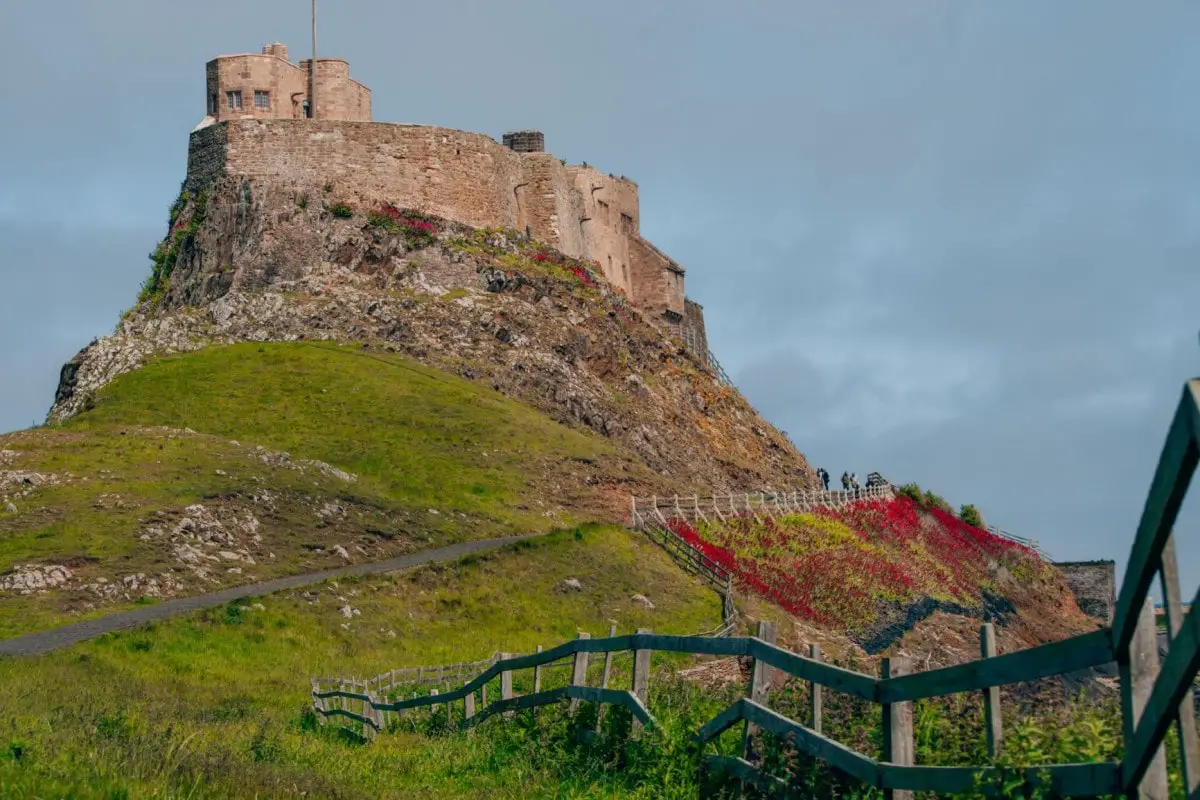
There are very few castles in England that can square up to the iconic Lindisfarne Castle. Perched atop a rocky hill overlooking the Northern Sea on the otherwise low-lying tidal isle of Holy Island, Lindisfarne not only has beauty, but unrivalled history.
Built in the 16th century with stones from the dissolved priory, the fortress was intended to protect from possible Scottish invasion and has served many military purposes over the years. Holy Island was even the site of the first Viking raids in England, which attacked the heart of the Northumbrian Kingdom.
The castle is now managed by the National Trust and tours can be made on certain days of the week. Even if you don’t go inside, the walk up to the castle is one of the island’s most popular activities.
Surrounded by lush green fields and stone walls to one side with wildflowers and coastal cliffs and beaches to the other, the flat walk is extremely pretty. It’s no wonder Lindisfarne Castle is one of the most photographed fortresses in the country!
Aside from Lindisfarne Castle, there are plenty of other things to do on Holy island such as visiting the priory ruins, tasting mead, enjoying fresh seafood, and walking around the wonderful churches (for which the island is named) and wonderful lanes lined with beautiful stone cottages. Just make sure you take note of the causeway times – as beautiful as the tidal island is – you wouldn’t want to get stuck there unexpectedly!
Kinder Scout, Peak District
Explored by Jenny from Peak District Kids
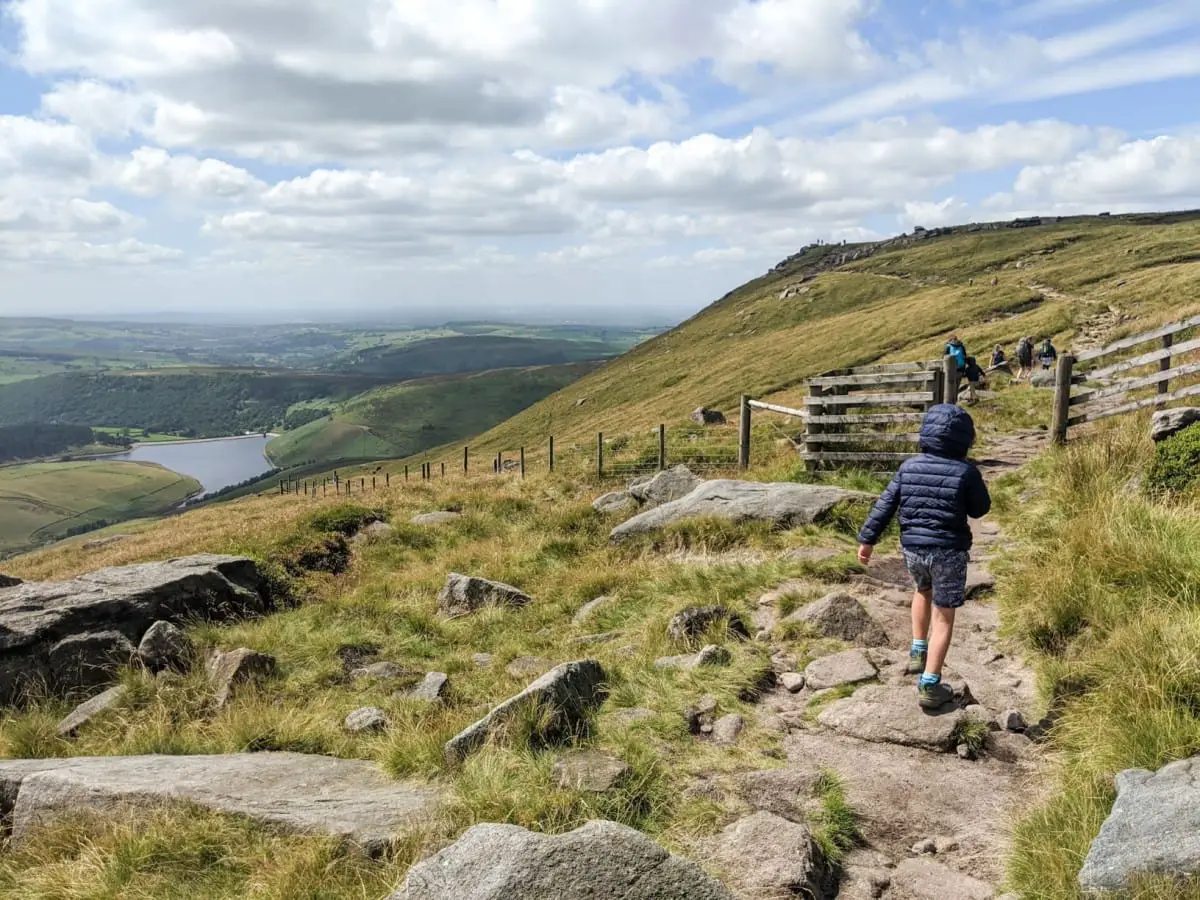
In 1932, around 500 walkers mostly from Manchester and Sheffield trespassed en masse from Hayfield to Kinder Scout to secure access rights to open country for all to enjoy. They rightfully believed that the open countryside should be for everyone, rather than the rich landowners, and the Kinder Scout Mass Trespass of 1932 (named after the moorland plateau) led to the Peak District becoming the UK’s first National Park.
Kinder Scout is the highest point in the Peak District and on a clear day you can see across to Manchester. It’s a steep climb up to the plateau from either Edale or Hayfield. You can even follow the route of the trespassers of 1932 up William Clough from Hayfield. Alternatively, follow this 14km Kinder Scout walk from Hayfield that provides a more gradual ascent, and brings you down William Clough.
Once you’re at the top, the hiking is relatively flat with unusual rock formations, a short detour to Kinder Low Trig Point (633 metres), and epic views. It’s worthwhile visiting the waterfall at Kinder Downfall en route.
However, if the hike up is a bit too energetic, take a short stroll along Kinder Reservoir from Hayfield, from where you can admire the craggy cliffs that mark the edge of the Kinder Scout plateau.
Blackpool Tower
Explored by Lee from The Travel Scribes
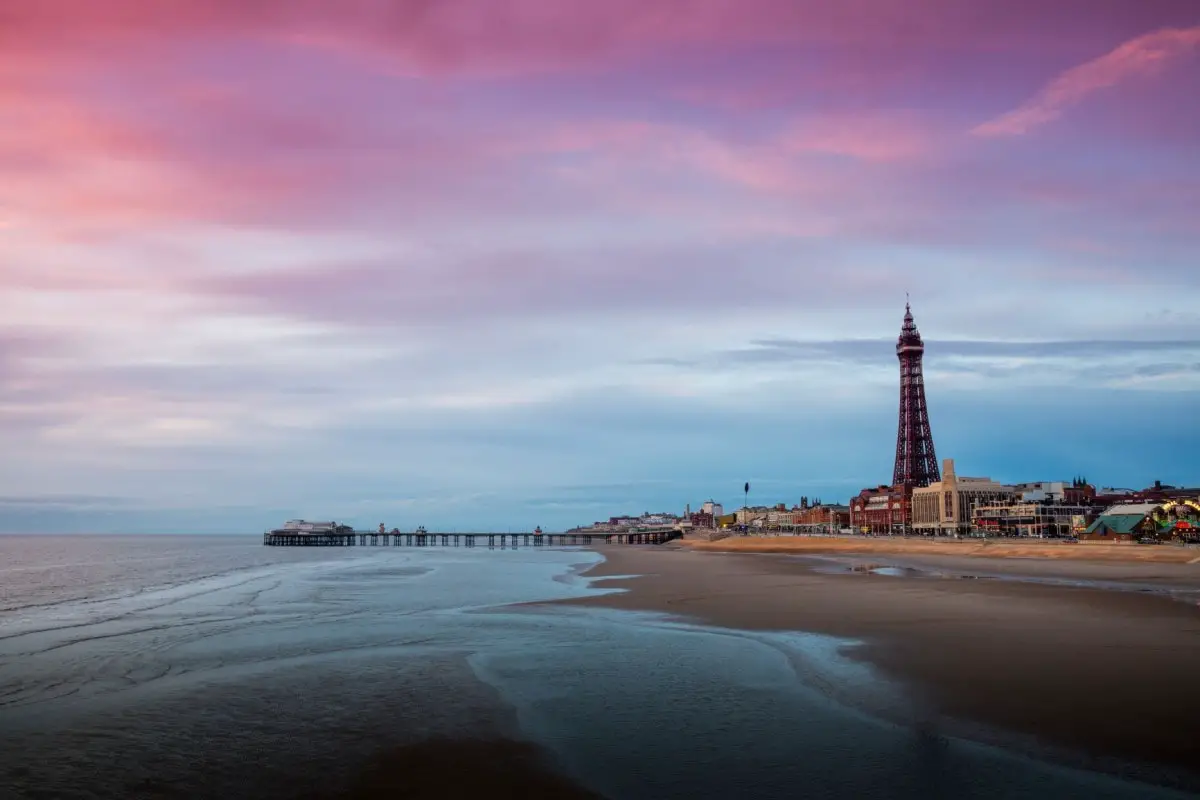
One of England’s best loved landmarks, Blackpool Tower was inspired by the Eiffel Tower and on it’s opening in 1984 was the tallest building in the country at 158 metres tall.
With some dubious beginnings – including bankruptcy and both the architects – James Maxwell and Charles Tuke – dying within the 3-year period of its construction, it debuted with much fanfare, as people flocked to see the British Empire’s loftiest structure.
Today there’s quite a bit to do at the Blackpool Tower which, actually, is not just the Tower but a collection of buildings including a circus, ballroom and gorgeous roof gardens. The very top of the tower, named the Blackpool Tower Eye, is also the highest observation deck in North West England (at about 380 feet or 120 metres high), offering up panoramic views of the Blackpool promenade.
Tower Bridge, London
Explored by Kenny from Knycx Journeying
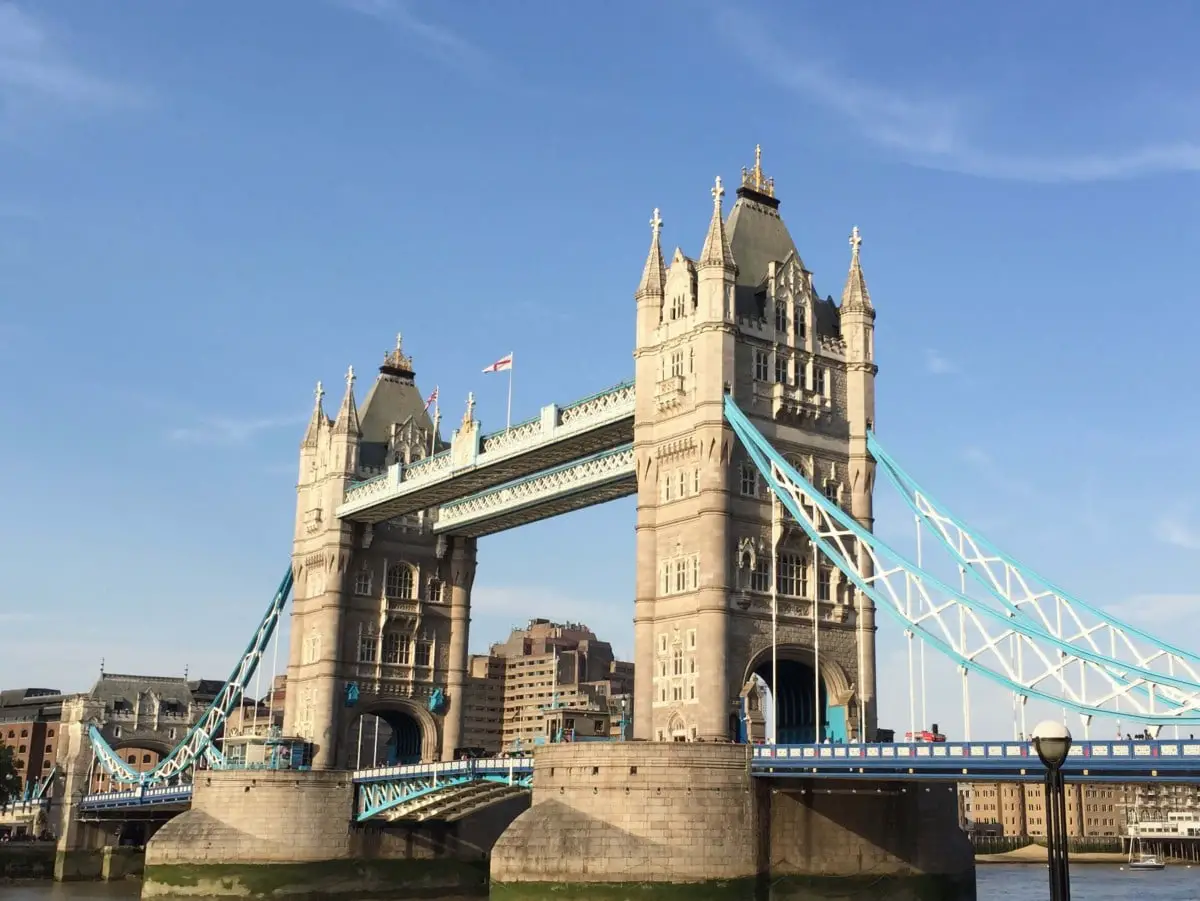
The Tower Bridge in London was built between 1886 and 1984, and since then it’s been one of the most recognisable symbols of the city. While most people always have mistaken that this is the bridge in the nursery rhyme “London Bridge is falling down”, the real London Bridge is actually half a mile upstream with no eye-catching architectural features like Tower Bridge.
While the bridge itself is a beautiful structure with two magnificent Gothic-style bridge towers and four strikingly blue suspension chains, it is also filled with monuments and historic writings. Its high-level walkway offers a panoramic view of the River Thames, from the nearby Tower of London, to the modern skyscrapers in Cornhill and London Bridge, HMS Belfast, and City Hall. If you are interested to learn more about the history and mechanics of the hundred-year-old structure, visitors may also sign up for a guided tour for a behind-the-scenes experience of its original machinery.
The bridge is located in the heart of London with lots of iconic attractions close by, and it’s easy for you just to spend a day in the area to explore some of London’s classic highlights either on foot or by bike.
The Minack Theatre, Cornwall
Explored by Jordan from Inspired by Maps
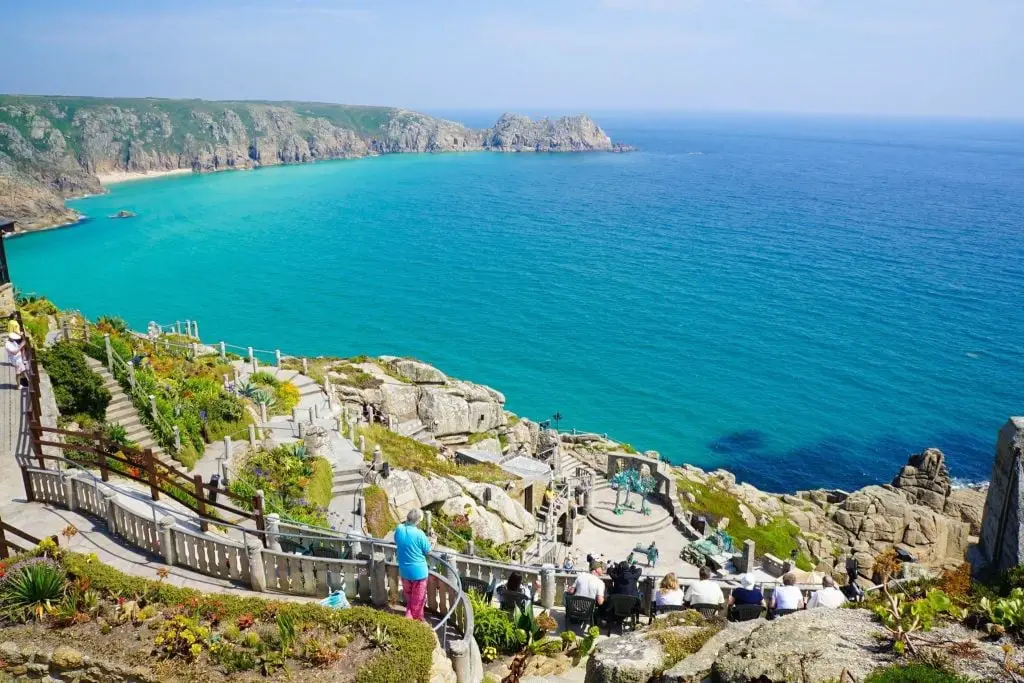
The Minack Theatre is a magnificent open-air theatre resting precariously on the granite Cornish cliffs of southern England. Not only is the Minack an astonishing place to visit with a wide range of shows, but it is a landmark of England – and one that should be on everyone’s list of things to do in Cornwall.
Constructed above a gully in Porthcurno, 6.4 kilometres from Land’s End in Cornwall, the Minack Theatre may look ancient but only arose after WW1 as the brainchild of Rowena Cade. A local performance ground had been using a nearby meadow and was offered the gardens of Miss Cade’s house for their new show. A terrace and seating were constructed, and after the first performance was deemed an exceptional success (how could it not with the dramatic ocean background?), a more permanent structure was built.
Further additions were made over the following decades, and in 1976, the theatre was registered as a Charitable Trust. The best way to experience the Minack is by watching a performance with seasons running between May to September each year. Around 80,000 people attend a show here each year, and more than 100,000 come just to look at the site.
The golden cliffs, the turquoise sea and the stunning surrounding gardens all combine to ensure the Minack is one of the world’s most unique and breath-taking theatres. Sometimes dolphins can even be seen splashing in the water below!
Related: Thinking of visiting the Minack Theatre? Why not add it as part of a London to Cornwall road trip?
Roman Baths, Bath
Explored by Samantha from A Truthful Traveler
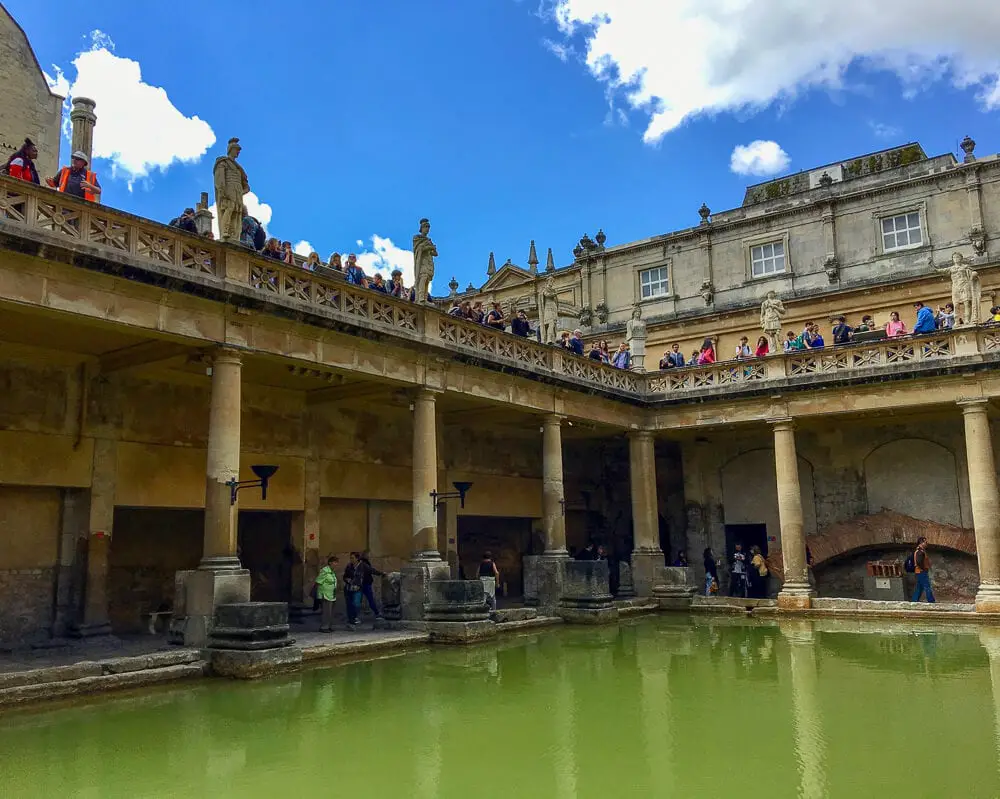
It’s no secret that the Roman empire once reached much further than the borders of Italy, and their presence in Bath left a lasting legacy. The Roman Baths are still standing today and are an iconic landmark to visit.
A visit to the Roman Baths allows you to step back in time to a very different era: Roman Britain. The original settlement of Aquae Sulis was built around the thermal baths, and until very recently the warm waters were still used for leisure purposes. The main attraction is the large main pool which you can walk around today. It is a deep green colour and opens up to the sky above. From the second level you can look out at the town and see the surrounding Abbey and buildings.
The large pool is not the only thing that remains of the settlement. On an audio tour of the Baths you walk through rooms filled with artefacts, visit other vantage points of the water that used to fill the baths, and even through an area where you can drink the spring water that is said to consist of 43 different minerals.
A trip to the Roman Baths in Bath is a step way back in time, and an interesting bit of history that is often forgotten! Visiting the landmark is a great way to see a glimpse of the Roman empire, without the hassle of having to travel all the way to Italy!
Big Ben & the Houses of Parliament
Explored by Catherine from We Go With Kids
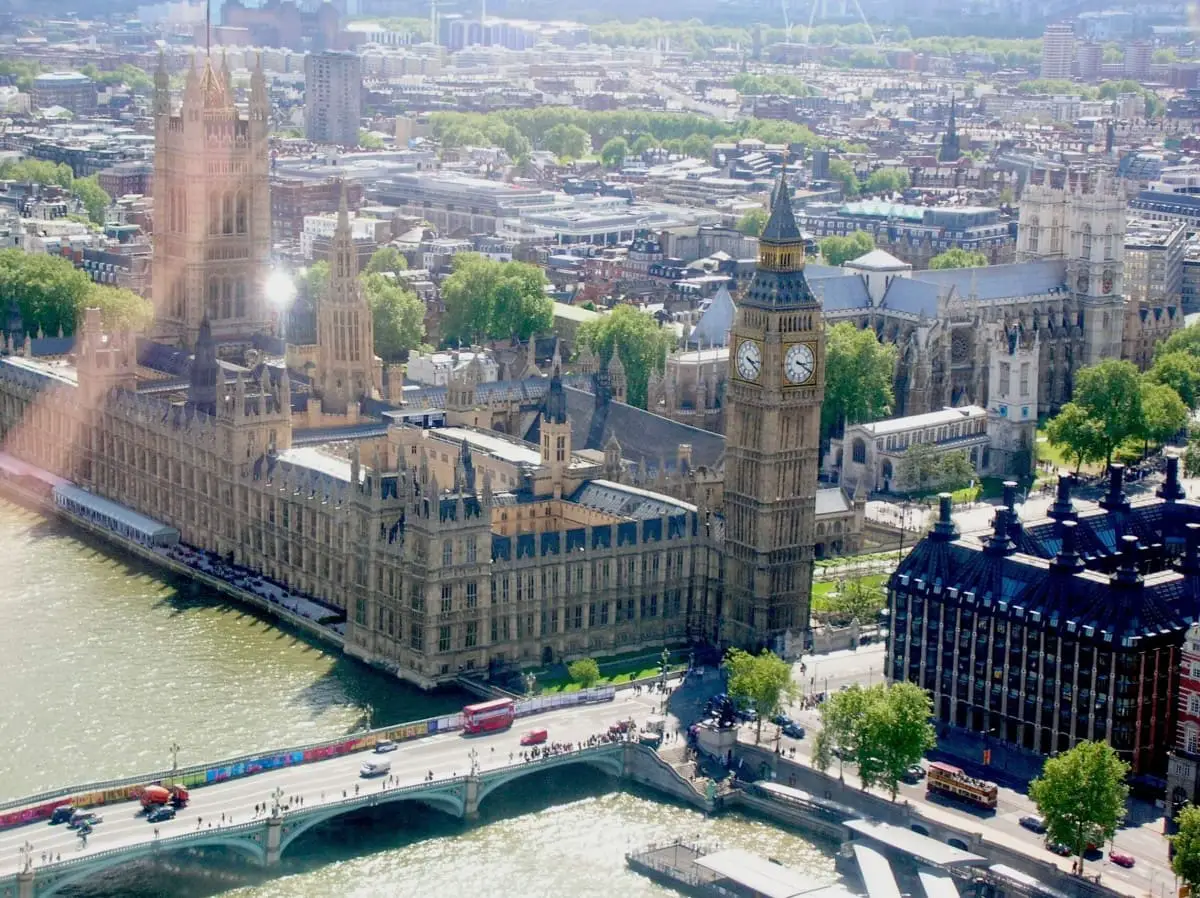
Big Ben and the Houses of Parliament are among the most recognisable of London’s landmarks. While it might be under construction for the foreseeable future, we were fortunate to have visited before the renovation began.
On our last visit, we took the Underground to the Westminster Station on our first day in the city so that our kids’ first view of central London upon emerging from the Tube would be Big Ben. They were not disappointed. While Big Ben is actually the nickname for the Great Bell of what is now known as Elizabeth Tower, it has become synonymous with the clock tower as well (sorry, Queen Elizabeth).
Adjacent to Big Ben is the Palace of Westminster, which includes both the House of Commons and House of Lords, which are collectively known as the Houses of Parliament. The current structure was constructed in the nineteenth century. The London Eye was built across the River Thames and capitalises on this amazing view.
Big Ben and the Houses of Parliament were two of our favourite sites in London. Make sure to spend some time walking on both banks of the River Thames to check out all the wonderful views.
York Minster
Explored by Maja from Away With Maja
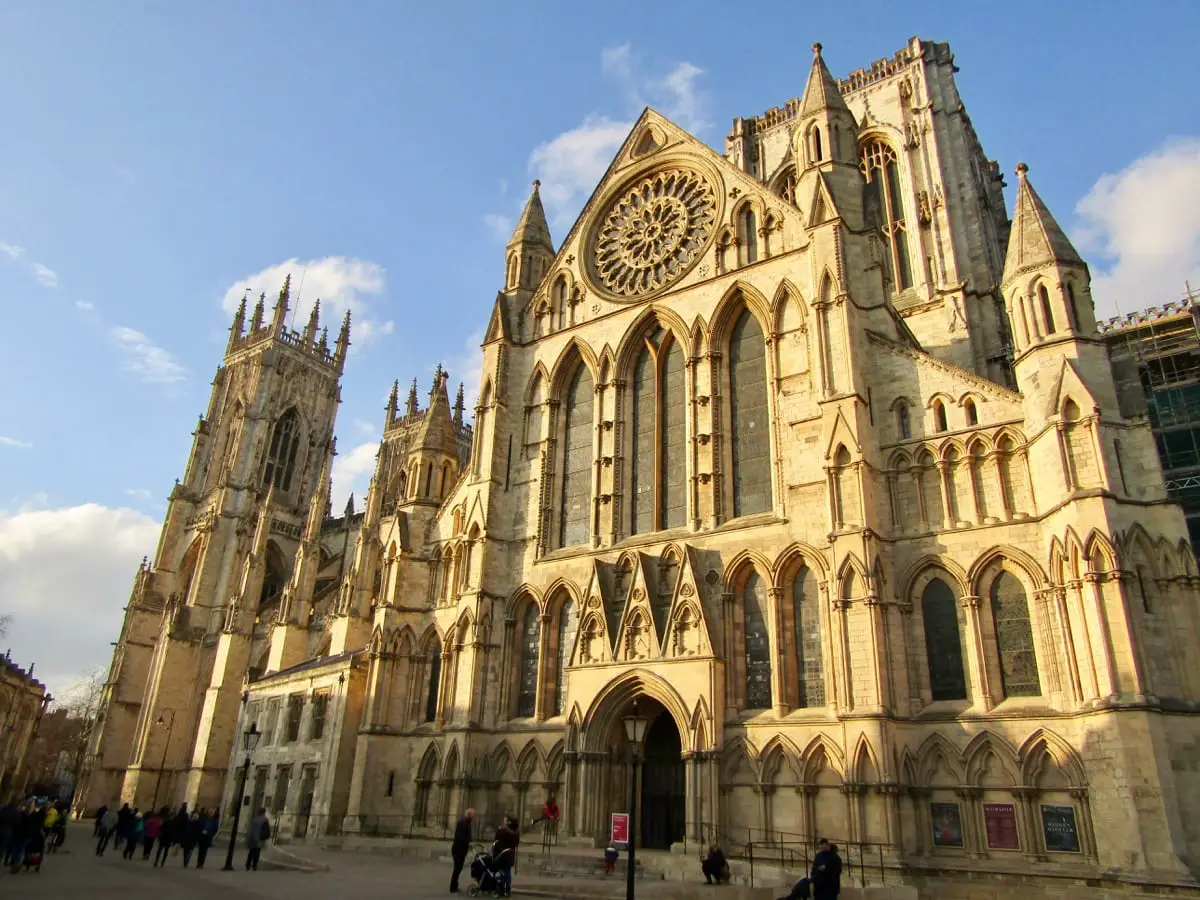
York is one of the most popular cities to visit in the north of England, and York Minster is the icon of this historic city. York Minster is one of the largest Gothic cathedrals in northern Europe, with most of the current structure dating back to the 1200-1400s.
It is also home to the largest collection of medieval stained glass in the country, which you can see in the Great East Window. The Chapter House is a spectacular area of the Minster to visit—the carvings in the canopies include angels, animals, and even a man picking his nose! No trip to York Minster would be complete without a visit to the fascinating Undercroft Museum. Below ground level, you can see the Norman and even Roman remains of the structures that stood in the same place thousands of years ago. There is even a Roman culvert that still has running water!
One of the best views of York Minster is from the central Tower. This view over the city of York from the Minster is one of the best in town. There is an admission charge for entry to support running costs of the building (11.50 GBP / 15 USD for adults), and a ticket that includes a Tower tour will be a few pounds more. However, if you aren’t interested in sightseeing, you can always attend a service at York Minster — these are free to attend. York Minster is a stunning building and one of the top places to visit in England!
Bamburgh Castle
Explored by Tracey from PackThePJs
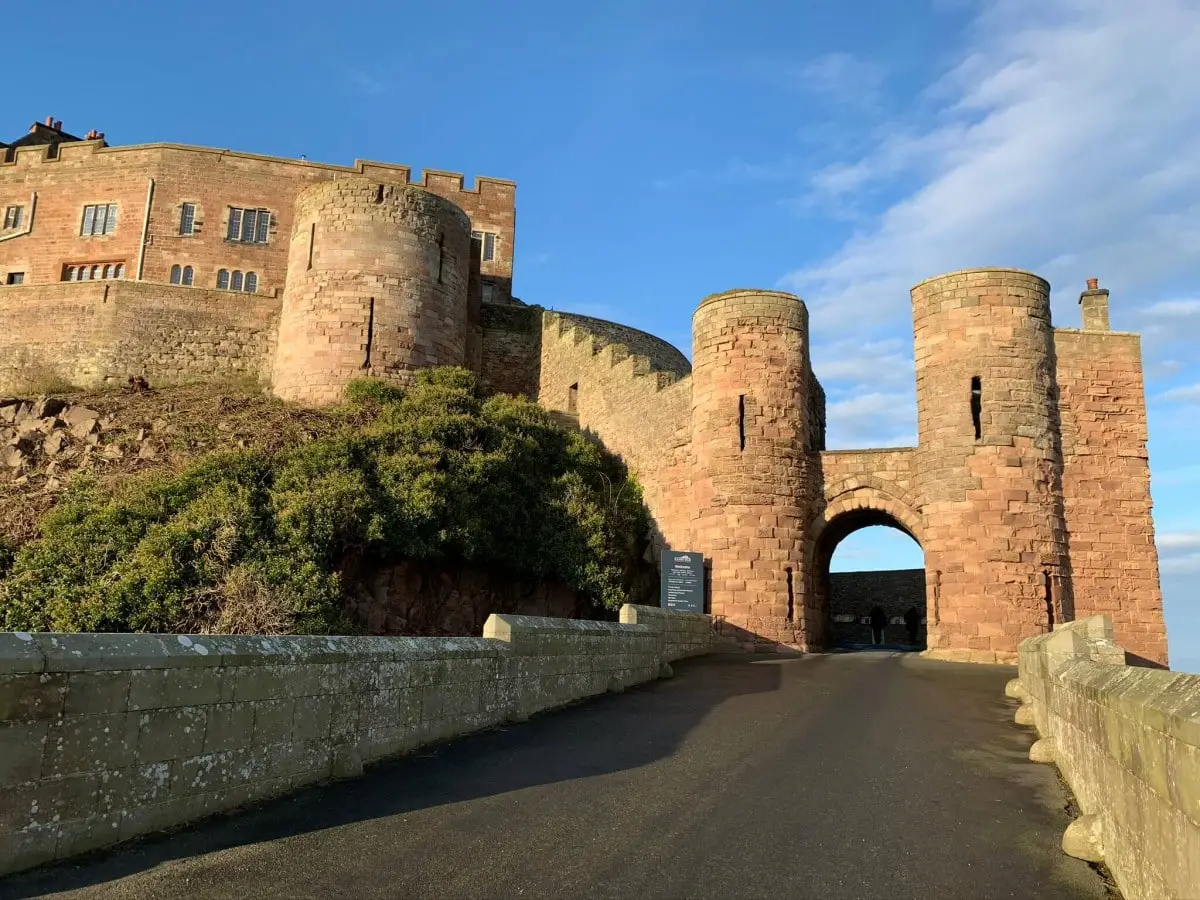
No trip to Northumberland is complete without a visit to Bamburgh Castle. Located along the beautiful east Northumbrian coast, this 11th Century castle is close to the village of Bamburgh. It was used as Hogwarts in the first two Harry Potter films, as Brancaster Castle in Downton Abbey and was also a location for Robin Hood: Prince of Thieves! It is a filmmaker’s dream – the castle and its setting are absolutely stunning.
Bamburgh Castle has become a very popular wedding venue. It is clear why the venue is in such demand when you are standing in the incredible King’s Hall. Day entry to the castle costs approximately 33 GBP (43 USD) for a family of two adults and two children, with an additional 3 GBP (4 USD) for parking. The castle grounds are dog-friendly; obviously they cannot go into the buildings, and must be kept on leads, but it meant we could take it in turns to look after the dogs while the other viewed the rooms. On site there’s an aviation museum and an archaeological museum, battlements and cannons, and the 14 state rooms that includes an armoury, dungeon and the King’s Hall. So, plenty to see!
The tearoom is lovely. For those with dogs, the Victorian stables has booths for sitting in – you can take your pets with you into here while you enjoy the tea, cakes and sandwiches on offer.
Bamburgh Castle often run themed events and workshops. You can easily spend the best part of a day at Bamburgh Castle.
Eden Project
Explored by Lee from The Travel Scribes

Last but definitely not least on this list of English attractions is one of the more curious landmarks in Cornwall, the Eden Project.
Constructed as a set of large geodesic biome domes, this interesting attraction houses thousands of different plan species – from environments meant to echo the rainforest, to Mediterranean climes and, of course, a botanical garden dedicated solely to the native plants of Cornwall and the United Kingdom.
More than just a botanist’s dream, the Eden Project is a great day out for friends and family alike. Marvel at the gardens, take one of the walking trails, saunter gingerly over the Rainforest Canopy Walkway or even get those pulses racing on the SkyWire, the country’s longest (660 metres) and fastest (60 miles per hour) zipline!
Movie buffs might recognise this famous monument, as it was used as a key filming location for the imitable James Bond film, Die Another Day.
Related: The most iconic landmarks and monuments in America
So, what do you think of all these incredible landmarks? Let us know if you think or if we’re missing of the must-visit English attractions in the comments below.
Want to save this for later? Why not pin it…


